- Skip to primary navigation
- Skip to main content
- Skip to primary sidebar

Activities to Teach How to Write A Thesis Statement
Research Writing , Secondary Literacy , Writing
If there’s any literacy skill you would want your English Language Arts students to master, it would probably be how to write a thesis statement . If you want to teach your students how to write powerful, eloquent, and exceptionally captivating thesis statements, then you’ll love the activities in this article.
The key to any good essay is a strong thesis statement. A strong thesis statement sets the tone and clarifies the author’s purpose : it tells you the writer’s opinion, along with the level of thought and criticism that has gone into formulating it.
A strong thesis statement also creates an alluring introduction paragraph. This makes each paper in your grading pile a lot more inviting.
How do you teach students to write a thesis statement to make their audience continue reading? This blog post explores six activities to teach how to write a thesis statement.
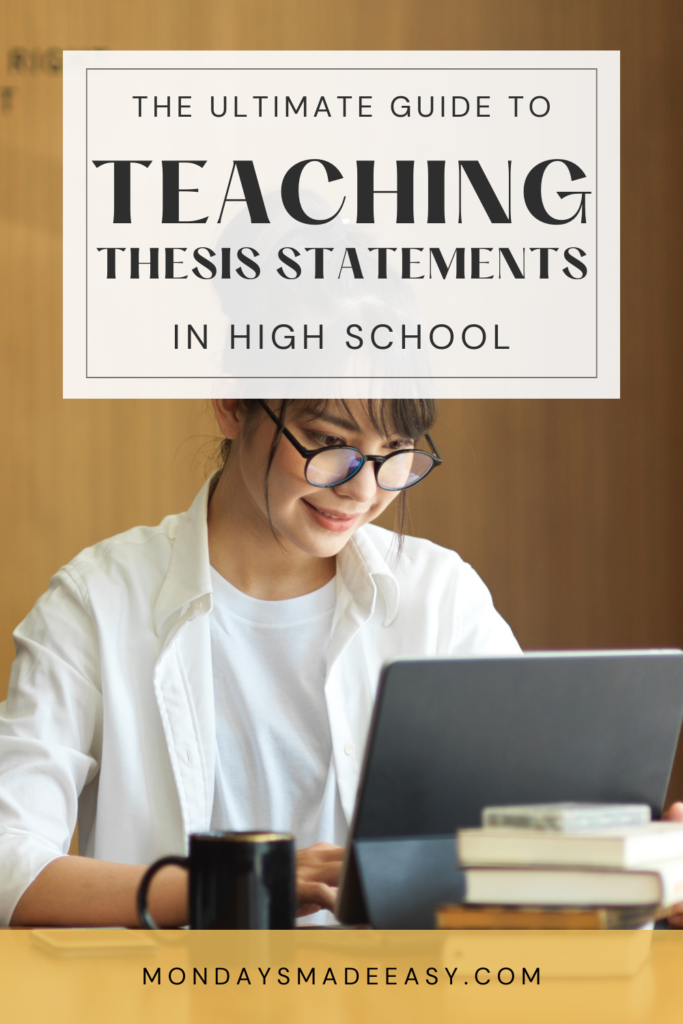
1. Differentiate Between Strong and Weak Thesis Statements
Writing a thesis statement might be a new skill for your students. Thesis statements are often taught as a topic sentence or the “whole essay boiled down into one sentence.” This can be a challenging concept for your students to grasp.
To teach how to write a thesis statement, have a discussion about what makes a strong thesis statement. You can turn this into a collaborative lesson by brainstorming clarifying statements ; these statements dictate what a thesis is and is not.
For example: “ A proper thesis statement is written in one sentence ,” or “ a proper thesis statement is directly related to the rest of the essay .” This is a great opportunity to teach students the difference between concepts like a “topic sentence” or a “hook.”
Your students can use this free bookmark to differentiate between a strong thesis statement and a weak one. This slideshow lesson also explores clarifying statements with detailed examples.

2. Evaluate Thesis Statement Examples
Now that students have plenty of guidelines, challenge their understanding by evaluating thesis statement examples . You can use thesis statement examples from past students’ essays. You can even write your own examples based on the clarifying statements you create with your class.
If you’re open to your students receiving constructive, anonymous criticism , you can even have them write a thesis statement and evaluate each one as a class. I’ve had success with providing students with a thesis statement topic and having them write a thesis statement. Then, I prompt them to swap with their elbow partner to offer feedback.
If you’d rather provide a comprehensive list of thesis statements that reflect the common errors you would typically see in students’ essays, there are several student examples in this introductory lesson on how to write a thesis statement – this is one of my favourite activities for teaching thesis statement writing!
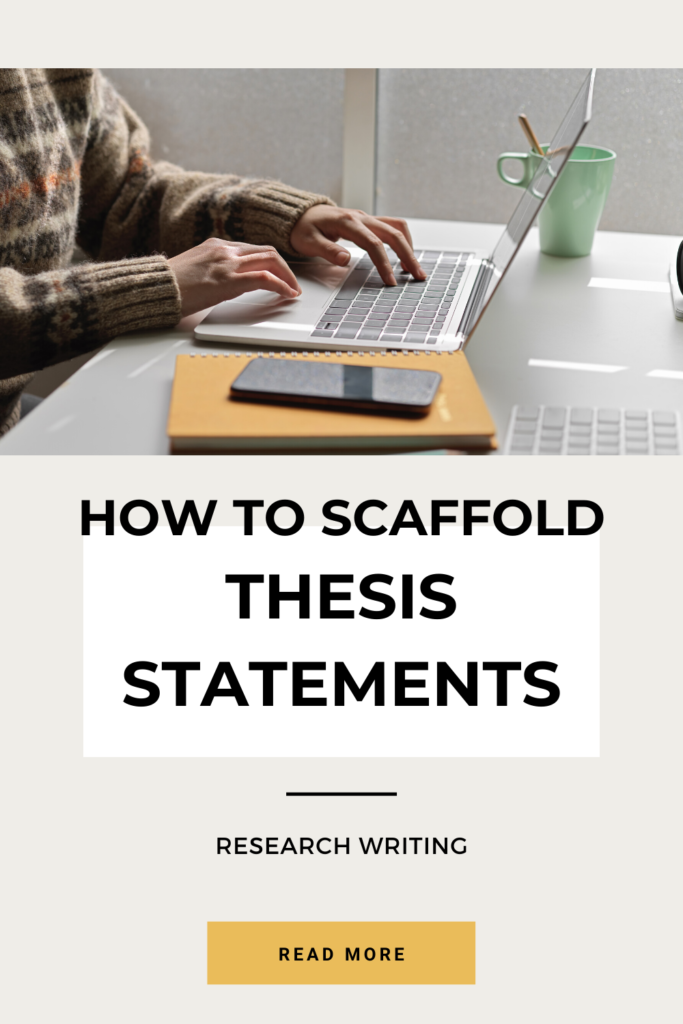
3. Provide a Thesis Statement Template
One of the easiest ways to teach how to write a thesis statement is to offer a thesis statement template . There are a variety of thesis statement templates that students can use as a framework for their essays. I start with a basic template that involves the three parts of a thesis statement: a topic, position, and evidence . I then demonstrate to students how they can create variations of this template, depending on which order they introduce each part. You can find examples for each template in these thesis statement handouts .
You can also introduce a few sentence styles to your students. These styles scaffold eloquent thesis statements. They also offer students the space to articulate their thoughts without exceeding the one-sentence limit.
Sentence Styles for the Three Parts of a Thesis Statement
Here are a few sentence styles that incorporate the three parts of a thesis statement. Each style also includes an example written by a real student:
- Style A : “Noun phrase; Noun phrase; Noun phrase – Independent Clause” Example: “The promotion of hygiene; the presence of medical professionals; the prevention of death – these are all reasons why supervised injection services are an important facet of public health.”
- Style B : If (subject + verb + object phrase), if (subject + verb + object phrase ), if (subject + verb + object phrase ), then (independent clause) Example: “If taxpayers do not wish to have their money allocated to cruelty, if more than 100 million animals die from animal testing a year, if alternatives to animal testing exist, then governments should ban the practice of testing on animals.”
- Style C : Independent clause: subject + verb, subject + verb, subject + verb Example: “College education should be entirely funded by the government: student debt would be eliminated, education would not be commodified, and access to education would not be exclusive to privileged people.”
All of these sentence styles are outlined in these practice worksheets for how to write a thesis statement, with writing prompts to reinforce each thesis statement template through repeated practice.
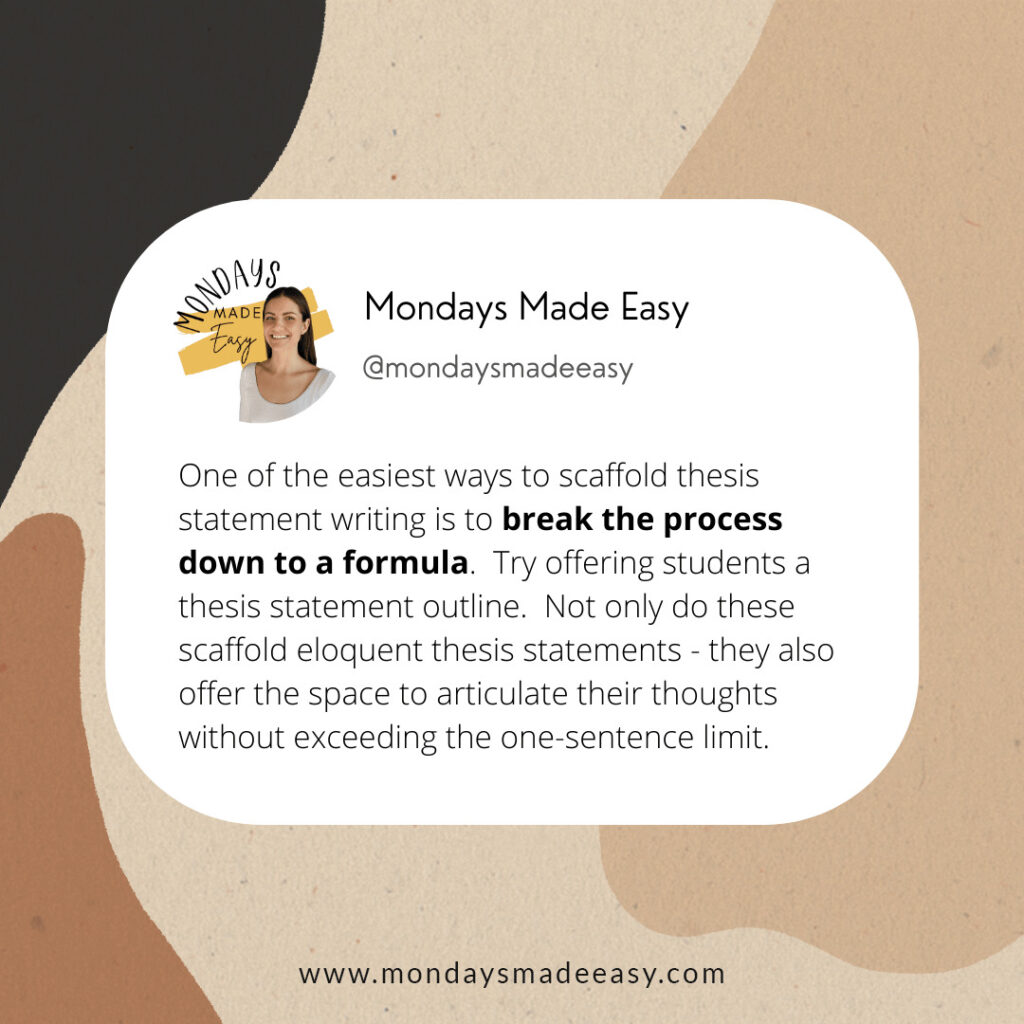
4. Daily Practice Activities to Teach How to Write a Thesis Statement
One of the most effective ways to teach how to write a thesis statement is through repeated practice. You can do this by incorporating daily bell ringers into your persuasive writing unit. To assign this activity, I provide students with three topics to choose from. I then prompt them to develop an opinion and write a thesis statement for one.
I’ll also include bell ringers that provide a thesis statement that students need to evaluate. Students really enjoy these drills! They get the opportunity to develop opinions on interesting topics, and many of them choose to explore these ideas as the subject of their final research paper.
If you’re looking for pre-made worksheets with thesis statement activities, these daily thesis statement bell ringers include one month’s worth of thesis statement prompts, graphic organizers, and templates in both digital and ready-to-print format.
5. Use a Self-Assessment Thesis Statement Anchor Chart
You can provide students with a thesis statement anchor chart to reference the guidelines and rules they’ve learned. A personalized anchor chart is best – like this free thesis statement bookmark – so that students can have it on hand while they are reading and writing.
You can distribute the anchor chart at the beginning of your research paper unit. Students can refer to it while evaluating thesis statement examples or completing daily practice activities. A thesis statement anchor chart has been a complete game-changer in my classroom, and I’m pleased to learn that many of my students have held on to these after completing my course.
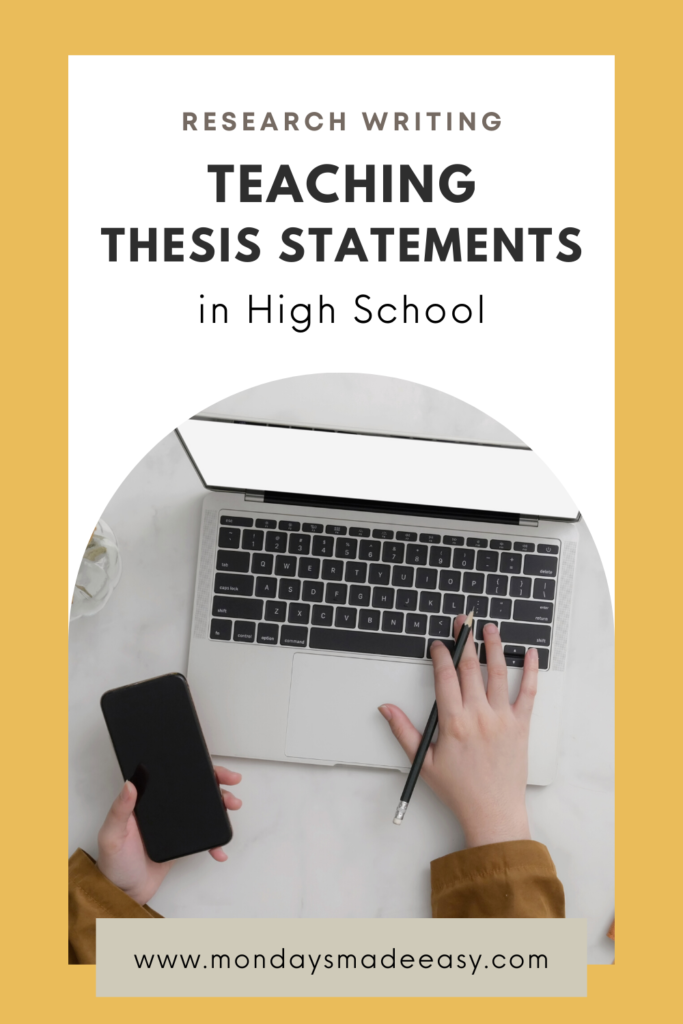
6. Provide Engaging Thesis Statement Topics
You can collaborate with your students to generate an engaging list of good topics for thesis statements. Start by writing down every topic that your students suggest. Then, you can narrow this list down to avoid broad, far-reaching thesis statements that lead to a watered-down essay. When I make this list with my students, we end up with topics that are truly engaging for them. I also have the opportunity to clarify which topics might be a little too vague or broad for an exceptional essay.
For example, students often suggest topics like “racism” or “the problem with school.” These are learning opportunities to demonstrate to students that a great thesis statement is the essential starting point for an even greater essay.
To elaborate, a topic like racism has different implications all over the world. It is far too complex to explore in a single, 750-word essay. Instead, we work together to narrow this topic down to something like “racism in the media,” or even better, “representation in Hollywood.”
Additionally, a topic like “the problem with school” is more of a conclusion. To solve this, we work backward to identify some of the aspects of our school that make it an obstacle . This can include uniforms, early starts, or cell phone policies. This process leads students to a more concise topic, like “cell phone policies in twenty-first-century schools.”
If you’re looking for engaging thesis statement topics to inspire your students, I’ve included a list of 75 argumentative essay topics in this practice unit for how to write a thesis statement .
Tying it All Together
There are plenty of fun thesis statement activities and practice lessons that you can incorporate into your curriculum. Give thesis statements the love and attention they deserve in the classroom – after all, they truly are the most important part of a research essay.
All of the worksheets, lessons, and activities explored in this blog post are included in Mondays Made Easy’s unit for teaching how to write a thesis statement . This bundle has everything you need to teach your students how to master their thesis statements and apply these essential literacy skills to their writing.
- Writing Worksheets and Other Writing Resources
- Thesis, Analysis, & Structure
Thesis Activity
About the slc.
- Our Mission and Core Values

One way to think about a thesis statement is:
An effective thesis is one that is not obvious; rather it is one that is discussible, arguable, and interesting.
Avoid self-evident statements.
In the US, movie stars are greatly admired.
A strong thesis will give readers an idea of the general direction of your paper and the evidence you will provide.
Because definitions of obscenity change as society changes, the Supreme Court has handed down three contradictory decisions on censorship in the past five years.
A few things to keep in mind:
- A thesis must be a complete sentence(s), not a fragment(s).
- A thesis should not be worded as a question.
- A thesis should neither be too broad nor too specific.
- A thesis should not contain elements which are extraneous or irrelevant to your paper.
- A thesis should avoid phrases like I think and in my opinion because they weaken the writer's argument.
Having said all of that, let's venture into never-never land, take a trip to the world of happily-ever-after. Let's look at fairy tales.
Take a common fairy tale. Little Red Riding Hood , for example. Your average tale of good vs. evil, right?
In my opinion, Little Red Riding Hood is a classic tale of good versus evil.
Now, there's a thesis that is sure to keep you up at night. Interesting. Innovative. Imaginative. I think not.
Let's try something else. How about:
Because she dares to defy societal norms of acceptable female behavior, Little Red Riding Hood faces death at the hands of the Big Bad Wolf, who embodies patriarchy.
Little Red Riding Hood serves as a feminist tale, demonstrating how an independent, intelligent woman subverts the entrenched forces of male power and privilege.
The forest in Little Red Riding Hood--with its various elements of danger, fear, and foreboding--symbolizes a young girl's rite of passage into womanhood; by challenging the elements in the forest, the naive and trusting Little Red Riding Hood emerges an empowered, mature, confident young woman.
Television shows and movies also offer a wealth of possible thesis statements. Consider the following:
As the middle child, Jan Brady is insecure and demonstrates a negative self-perception: she feels inferior to Marcia, who embodies the qualities of the "ideal" teenager and to Cindy, the "innocent" child and center of the family's attentions.
While appearing to be a simplistic situation comedy about a group of castaways, Gilligan's Island is actually a complex representation of vice; each of the characters represents one of the seven deadly sins.
While Star Trek : The Next Generation may appear to represent an ideal version of a multicultural, gender-equal society, the command structure on the Enterprise, headed by Picard and Riker, reinscribes western, patriarchal notions of power.
Although praised for its realism, Saving Private Ryan glorifies American patriotism and heroism, excluding alternative perspectives.
Now it is your turn. Construct an interesting, compelling thesis using a fairy tale, television show, popular song, or movie.
Luisa Giulianetti Student Learning Center, University of California, Berkeley ©1998 UC Regents
This work is licensed under a Creative Commons Attribution-NonCommercial-NoDerivs 3.0 Unported License.
Fun Ways to Teach Thesis Statements for High Schoolers
- Trent Lorcher
- Categories : High school english lesson plans grades 9 12
- Tags : High school lesson plans & tips
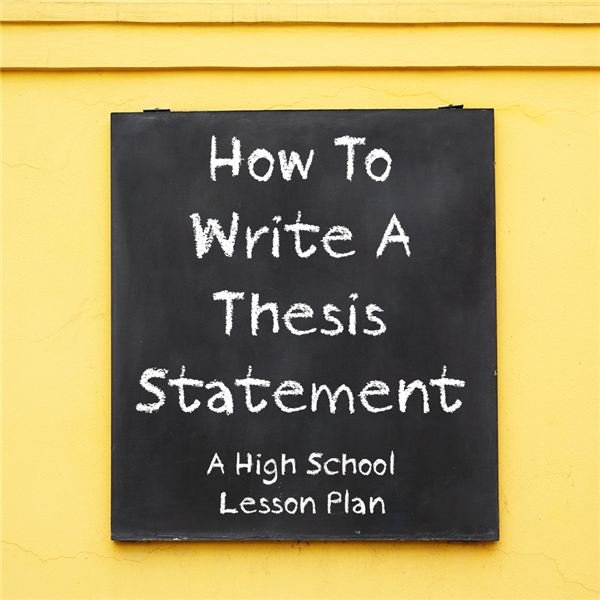
The Thesis Statement Dilemma
[caption id="" align=“aligncenter” width=“600”]
On my way out the door, I noticed all the English teachers were busily grading essays . “Hey, Bob,” I shouted as I stumbled into his classroom, “Not done with those essays yet? I finished mine an hour ago.” “How’d you grade them so fast?” he asked. “It’s simple,” I responded, “I didn’t teach my students how to write a thesis statement, so grading their essays was easy. I just gave them all F’s. While you guys waste your time teaching valuable lessons and then having to actually grade their essays, we watch movies.” “So, none of your students know anything about writing?” “Nope.” “You’re a disgrace!” Bob shouted. He moved toward me, stapler in hand. Next thing I remember, I was surrounded by angry tax-payers. Angry tax-payer #1 shouted, “Get up you thief! Our tax dollars pay your salary and you’re supposed to teach the children of this great state how to write! I suggest you start doing your job tomorrow morning, or you’ll pay dearly!” The angry tax-payer clubbed me with a ruler and knocked me out again. When I awoke, Bob was asking me if I wanted to learn some fun ways to teach thesis statements to my students. I now share these ideas with you.
What to Do Before Writing

- You must begin with a topic question. If your instructor has assigned an essay question to answer, this step has been done for you. If you are doing a research paper, take time to come up with a good topic question.
- You must form an opinion and state it clearly. Do not be wishy-washy.
- Be sure you have approached your evidence fairly, without bias.
- Consider both sides of a controversial issue.
- Once you’ve established the topic question, a clear position, and objectivity, you’re ready to write a thesis statement.
What Is a Thesis Statement?
Students have heard the term thesis statement hundreds of times by the time they reach high school, yet have only a vague understanding of what one is. Your first responsibility is to teach them that a thesis statement:
- Presents your opinions or thoughts on a subject or an issue. You cannot write an essay without one.
- Must contain a subject + an opinion.
- Answers the topic question (the one you created or the one presented to you by the instructor).
TIP : A thesis statement should never contain the following: in my opinion, I think, I believe , etc. Tell them that the entire thesis represents what they believe. However, it may be helpful for students to begin their thesis statement rough draft with i_n my opinion, I believe, or I think_ to make sure they are expressing their thoughts or opinion on a specific subject or issue. When writing the final draft, simply eliminate those phrases.
How to Teach Students to Write A Thesis Statement
It is important to demonstrate the difference between good and bad thesis statements. These instructions will help you teach the former:
- Good Example: Success is a result of doing the right things consistently.
- Bad Example: In a world full of success gurus and books about success, it becomes ever so more important to delineate the one trait that ultimately determines success: doing the right things consistently.
- Good example: The key to successful dieting is focusing on a specific goal.
- Bad example: T_he key to successful dieting is focusing on a specific goal, which is also the key to successfully running a business and coaching a football team._
- Good example: Lebron James’ ability to score, pass, and rebound make him the league’s most valuable player.
- Bad example: Does Lebron James’ ability to score, pass, and rebound make him the league’s most valuable player?
- Bad Example: Lebron James’ ability to score, pass, and rebound just might make him the league’s most valuable player.
Write It Out
Knowing what to do and actually doing it are not the same thing. The following steps will help you and your students write clearly:
- Write several trial statements: writing is a process - you don’t have to get it perfect on the first try. Teach your students to revise their work .
- If you’re having trouble deciding which side to take on a controversial issue, write your thesis statement from two different points of view. Then decide which one better represents your opinion. If you still can’t decide, list facts on both sides of the issue and decide which facts make a more persuasive argument.
Evaluating the Work
You’ve spent a lot of valuable classroom time teaching thesis statements, but your lesson is not finished without teaching your students how to evaluate their writing. Instruct students to use the following questions to analyze their statement:
- Good example: Romeo’s prior feelings for Rosaline diminish the credibility of his love for Juliet.
- Bad example: This essay examines whether or not Romeo’s prior feelings for Rosaline diminish his love for Juliet.
- Good example: Juliet was not the first woman to capture Romeo’s fancy; she was, however, the one who affected him the most.
- Bad example: Romeo loved Juliet with all his heart, but he loved Rosaline too. It could be argued they were both his favorite.
- Bad example: Immature, whiny, male-pig Romeo, a male harlot, ruined precious Juliet whom he loved no more than Rosaline.
More Teaching Ideas
The following activities will help reinforce the concept.
- Have students create thesis statements on a slice of paper. Collect the paper and read them to the class. Have the class vote on them.
- Do the same activity, but use individualized white boards to record judgments .
- Read the thesis statements anonymously. The ones that do not qualify get tossed in the garbage can (visualizing what happens to writing is powerful). Give students a chance to rewrite until they get it right.
- Write random topics on the board and have groups of students brainstorm good ones.
- Make the thesis statements part of a writing challenge .
- Require that students get thesis statements approved before writing an essay.
Click here for a complete 1st semester curriculum map for language arts with lesson plans and links. I hope you learned some fun ways to teach thesis statements to your students. If you have other tips, be sure to leave them in the comments. Image by Nicholas Jackson from Pixabay

Thesis Writing Activities: LEGOs, Graphic Organizers, and Superman
Thesis statement graphic organizer, thesis statement writing workshop, station 1: pick the best, station 2: block party, station 3: map it, station 4: rewrite it, station 5: thesis csi, closure: write your own (exit pass), essay roadmap, essay outline generator, fairy tale grab bags, start early.
A thesis statement is one or more sentences on an issue or topic that takes a position and offers reasons for support.
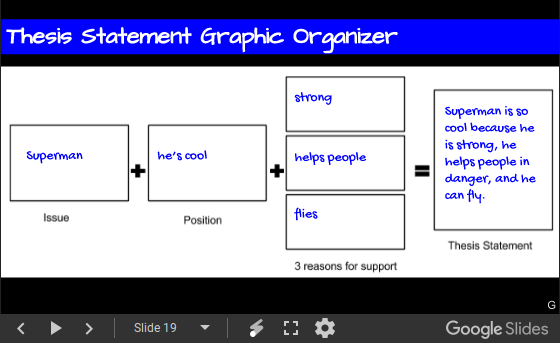
ASCD is a community dedicated to educators' professional growth and well-being.
Let us help you put your vision into action., to process a transaction with a purchase order please send to [email protected].
Thank you for adding to your shopping cart! Please note, ASCD will be performing necessary website maintenance and upgrades from May 29 through June 2. During this time, we will be unable to finalize purchases. Learn more
Reading Worksheets, Spelling, Grammar, Comprehension, Lesson Plans
How to Write a Thesis Statement
About this worksheet:.
Practice developing thesis statements with this writing introduction worksheet! Students will learn how to improve their writing with a strong, attention grabbing thesis statement. This activity helps build writing skills by asking students to create a statement for the topics provided, such as: “What was the greatest challenge in your life?”.
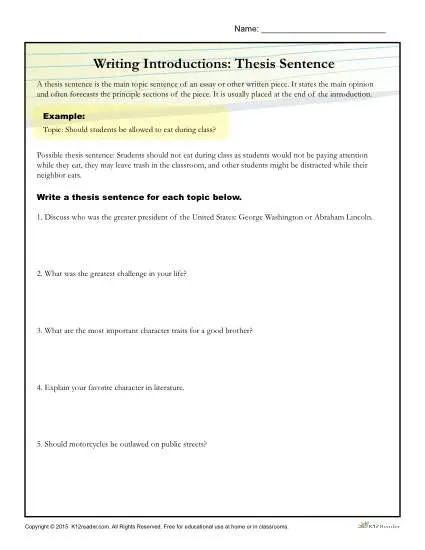

Top 3 Product Matches

Adventures of Tom Sawyer
Retail Price: $9.95 Our Price: $7.46 or less

Reproducible
Our Price: $19.95

Downloadable PDF File
Our Price: $14.95
Free Lesson Plans For Teachers
Sign up to get the latest posters, lesson plans, eBooks, puzzles, How to Teach guides, and webinars - for free!
- Crossword Puzzles
- Lesson Plans
- How to Teach Guides
- Other Resources
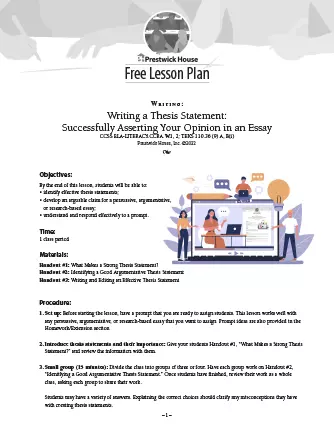
Writing a Thesis Statement Free Lesson Plan
Here is a guided writing workshop to teach students how to brainstorm and draft a thesis statement. This activity provides students an opportunity to consider their prompt and develop a claim that is effective and arguable. Three handouts are included in each download, with the teacher version also containing instructions on how to conduct the workshop.
This lesson plan can be used with any persuasive, argumentative, or research-based essay.
Newsletter Signup
Information and Products
- Privacy Policy
- Terms of Service
- Popular Searches
- Payment Information
- Grammar & Writing
- More Resources
- Order By Catalog Code
Customer Service
1.800.932.4593
Connect With Us
Copyright 2024 Prestwick House. All Rights Reserved.

In-Class Writing Exercises
If you find yourself wishing your students would write more thoughtful papers or think more deeply about the issues in your course, this handout may help you. At the Writing Center, we work one-on-one with thousands of student writers and find that giving them targeted writing tasks or exercises encourages them to problem-solve, generate, and communicate more fully on the page. You’ll find targeted exercises here and ways to adapt them for use in your course or with particular students.
Writing requires making choices. We can help students most by teaching them how to see and make choices when working with ideas. We can introduce students to a process of generating and sorting ideas by teaching them how to use exercises to build ideas. With an understanding of how to discover and arrange ideas, they will have more success in getting their ideas onto the page in clear prose.
Through critical thinking exercises, students move from a vague or felt sense about course material to a place where they can make explicit the choices about how words represent their ideas and how they might best arrange them. While some students may not recognize some of these activities as “writing,” they may see that doing this work will help them do the thinking that leads to easier, stronger papers.
Brainstorming
In order to write a paper for a class, students need ways to move from the received knowledge of the course material to some separate, more synthesized or analyzed understanding of the course material. For some students this begins to happen internally or through what we call “thinking,” unvoiced mulling, sorting, comparing, speculating, applying, etc. that leads them to new perspectives, understanding, questions, reactions about the course material. This thinking is often furthered through class discussion and some students automatically, internally move from these initial sortings of ideas into complex, logical interpretations of material at this point. But, for more students, their thinking will remain an unorganized, vague set of ideas referring to the subject. Many will have trouble moving beyond this vague sense or simple reaction toward ideas that are more processed, complex, or what we often call “deep.” We can foster that move to a deeper understanding by providing opportunities to externalize and fix their ideas on paper so that they may both see their ideas and then begin to see the relationships between them. The following activities will help students both generate and clarify initial responses to course material:
- Free-writing. Find a clock, watch, or timer to help you keep track of time. Choose a topic, idea, question you would like to consider. It can be a specific detail or a broad concept-whatever you are interested in exploring at the moment. Write (on paper or on a computer) for 7-10 minutes non-stop on that topic. If you get stuck and don’t know what to say next, write “I’m stuck and don’t know what to say next…” or try asking yourself “what else?” until another idea comes to you. Do not concern yourself with spelling, grammar, or punctuation. Your goal is to generate as much as you can about the topic in a short period of time and to get used to the feeling of articulating ideas on the page. It’s ok if it’s messy or makes sense only to you. You can repeat this exercise several times, using the same or a variety of topics connecting to your subject. Read what you have written to see if you have discovered anything about your subject or found a line of questioning you’d like to pursue.
- Clustering/Webbing. Find a clock, watch, or timer to help you keep track of time. Put a word you’d like to explore in the center of a piece of paper and put a circle around it. As fast as you can, free-associate or jot down anywhere on the page as many words as you can think of associated with your center word. If you get stuck, go back to the center word and launch again. Speed is important and quantity is your goal. Don’t discount any word or phrase that comes to you, just put it down on the page. Jot words for between 5-10 minutes. When you are finished you will have a page filled with seemingly random words. Read around on the page and see if you have discovered anything or can see connections between any ideas.
- Listing. On a piece of paper list all the ideas you can think of connected to subjects you are considering exploring. Consider any idea or observation as valid and worthy of listing. List quickly and then set your list aside for a few minutes. Come back and read your list and do the exercise again.
- Cubing. This technique helps you look at your subject from six different points of view (imagine the 6 sides of a cube and you get the idea). Take your topic or idea and 1) describe it, 2) compare it, 3) associate it with something else you know, 4) analyze it (meaning break it into parts), 5) apply it to a situation you are familiar with, 6) argue for or against it. Write at a paragraph, page, or more about each of the six points of view on your subject.
- Journalistic questions. Write these questions down the left hand margin of a piece of paper: Who? What? Where? When? How? And Why? Think about your topic in terms of each question.
- What? So What? Now what? To begin to explore an idea first ask yourself, “What do I want to explore?” and write about that topic for a page or more. Then read what you have written and ask “So what?” of the ideas expressed so far. Again, write for a page or more. Finally ask yourself, “Now what?” to begin to think about what else you might consider or where you might go next with an idea.
- Defining terms. Although this suggestion is simple and may seem obvious, it is often overlooked. Write definitions for key terms or concepts in your own words. Find others’ articulations of the terms in your course readings, the dictionary, or in conversations, and compare these definitions to your own. Seek input from your instructor if you can’t get a working definition of a term for yourself.
- Summarizing positions. Sometimes it’s helpful to simply describe what you know as a way to solidify your own understanding of something before you try to analyze or synthesize new ideas. You can summarize readings by individual articles or you can combine what you think are like perspectives into a summary of a position. Try to be brief in your description of the readings. Write a paragraph or up to a page describing a reading or a position.
- Metaphor writing. Metaphors or similes are comparisons sometimes using the words “like” or “as.” For example, “writing is like swimming” or the “sky is as blue as map water” or “the keyboard wrinkled with ideas.” When you create a metaphor, you put one idea in terms of another and thereby create a new vision of the original idea. Sometimes it may be easier to create a metaphor or simile may help you understand your view of an idea before you can put it fully into sentences or paragraphs. Write a metaphor or simile and then explain to someone why your metaphor works or what it means to you.
- Applying ideas to personal circumstance or known situations. Sometimes ideas come clearest when you can put them in a frame that is meaningful to you. Take a concept from your reading assignments and apply it so a situation in your own life or to a current event with which you are familiar. You may not end up using this application in your final draft, but applying it to something you know will help you to understand it better and prepare you to analyze the idea as your instructor directs.
Once students have something on the page to work with, they can begin the decision-making process crucial to developing a coherent idea or argument. At this point, students will choose which ideas most appeal to them, which ideas seem to fit together, which ideas need to be set aside, and which ideas need further exploration. The following activities will help students make decisions as they shape ideas:
- Drawing diagrams. Sometimes it helps to look for the shape your ideas seem to be taking as you develop them. Jot down your main ideas on the page and then see if you can connect them in some way. Do they form a square? A circle? An umbrella with spokes coming down? A pyramid? Does one idea seem to sit on a shelf above another idea? Would equal signs, greater or less signs help you express the relationships you see between your idea? Can you make a flow chart depicting the relationships between your ideas?
- Making charts or piles. Try sorting your ideas into separate piles. You can do this literally by putting ideas on note cards or scraps of paper and physically moving them into different piles. You can do this on the page by cutting and pasting ideas into a variety of groups on the computer screen. You can also make charts that illustrate the relationships between ideas. Common charts include timelines, authors sitting around a dinner table, and comparison/contrast charts.
- Scrap pile. Be prepared to keep a scrap pile of ideas somewhere as you work. Some people keep this pile as a separate document as they work; others keep notes at the bottom of a page where they store scrap sentences or thoughts for potential use later on. Remember that it is sometimes important to throw out ideas as a way to clarify and improve the ones you are trying to develop along the way.
- Shifting viewpoints (role-playing). When you begin to feel you have some understanding of your idea, it sometimes helps to look at it from another person’s point of view. You can do this by role-playing someone who disagrees with your conclusions or who has a different set of assumptions about your subject. Make a list or write a dialogue to begin to reveal the other perspective.
- Applying an idea to a new situation. If you have developed a working thesis, test it out by applying it to another event or situation. If you idea is clear, it will probably work again or you will find other supporting instances of your theory.
- Problem/Solution writing. Sometimes it helps to look at your ideas through a problem-solving lens. To do so, first briefly outline the problem as you see it or define it. Make sure you are through in listing all the elements that contribute to the creation of the problem. Next, make a list of potential solutions. Remember there is likely to be more than one solution.
- Theory/application writing. If your assignment asks you to develop a theory or an argument, abstract it from the situation at hand. Does your theory hold through the text? Would it apply to a new situation or can you think of a similar situation that works in the same way? Explain your ideas to a friend.
- Defining critical questions. You may have lots of evidence or information and still feel uncertain what you should do with it or how you should write about it. Look at your evidence and see if you can find repeated information or a repeated missing piece. See if you can write a question or a series of questions that summarize the most important ideas in your paper. Once you have the critical questions, you can begin to organize your ideas around potential answers to the question.
- Explaining/teaching idea to someone else. Sometimes the most efficient way to clarify your ideas is to explain them to someone else. The other person need not be knowledgeable about your subject-in fact it sometimes helps if they aren’t familiar with your topic-but should be willing to listen and interrupt you when he or she doesn’t follow you. As you teach your ideas to someone else, you may begin to have more confidence in the shape of your ideas or you may be able to identify the holes in your argument and be more able to fix them.
- Lining up evidence. If you think you have a good idea of how something works, find evidence in your course material, through research in the library or on the web that supports your thinking. If your ideas are strong, you should find supporting evidence to corroborate your ideas.
- Rewriting idea. Sometimes what helps most is rewriting an idea over the course of several days. Take the central idea and briefly explain it in a paragraph or two. The next day, without looking at the previous day’s writing, write a new paragraph explaining your ideas. Try it again the next day. Over the course of three days, you may find your ideas clarifying, complicating, or developing holes. In all cases, you will have a better idea of what you need to do next in writing your draft.
As students have been working with their ideas, they have been making a series of choices about their ideas that will lead them to feel “ready” to put them in a more complete, coherent form; they will feel “ready to write” their ideas in something closer to the assignment or paper form. But for most, the tough moments of really “writing” begin at this point. They may still feel that they “have ideas” but have trouble “getting them on the page.” Some will suddenly be thrust into “writing a paper” mode and be both constrained and guided by their assumptions about what an assignment asks them to do, what academic writing is, and what prior experience has taught them about writing for teachers. These exercises may ease their entry into shaping their ideas for an assignment:
- Clarify all questions about the assignment. Before you begin writing a draft, make sure you have a thorough understanding of what the assignment requires. You can do this by summarizing your understanding of the assignment and emailing your summary to your TA or instructor. If you have questions about points to emphasize, the amount of evidence needed, etc. get clarification early. You might try writing something like, “I’ve summarized what I think I’m supposed to do in this paper, am I on the right track?
- Write a letter describing what the paper is going to be about. One of the simplest, most efficient exercises you can do to sort through ideas is to write a letter to yourself about what you are planning to write in your paper. You might start out, “My paper is going to be about….” And go on to articulate what evidence you have to back up your ideas, what parts still feel rough to you about your ideas. In about 20 minutes, you can easily have a good sense of what you are ready to write and the problems you still need to solve in your paper.
- Write a full draft. Sometimes you don’t know what you think until you see what you’ve said. Writing a full draft, even if you think the draft has problems, is sometimes important. You may find your thesis appears in your conclusion paragraph.
- Turn your ideas into a five-minute speech. Pretend you have to give a 5 minute speech to your classmates. How would you begin the speech? What’s your main point? What key information would you include? How much detail do you need to give the listener? What evidence will be most convincing or compelling for your audience?
- Make a sketch of the paper. Sometimes it helps to literally line up or order you evidence before you write. You can do so quickly by making a numbered list of your points. Your goal is something like a sketch outline—first I am going to say this; next I need to include this point; third I need to mention this idea. The ideas should flow logically from one point to the next. If they don’t-meaning if you have to backtrack, go on a tangent, or otherwise make the reader wait to see the relationship between ideas, then you need to continue tinkering with the list.
- Make an outline. If you have successfully used formal outlines in the past, use one to structure your paper. If you haven’t successfully used outlines, don’t worry. Try some of the other techniques listed here to get your ideas on the page
- Start with the easiest part. If you have trouble getting started on a draft, write what feels to you like the easiest part first. There’s nothing magic about starting at the beginning-unless that’s the easiest part for you. Write what you know for sure and a beginning will probably emerge as you write.
- Write the body of the paper first. Sometimes it’s helpful NOT to write the beginning or introductory paragraph first. See what you have to say in the bulk of your draft and then go back to craft a suitable beginning.
- Write about feelings about writing. Sometimes it’s helpful to begin a writing session by spending 5-10 minutes writing to yourself about your feelings about the assignment. Doing so can help you set aside uncertainty and frustration and help you get motivated to write your draft.
- Write with the screen turned off. If you are really stuck getting starting or in the middle of a draft, turn the monitor off and type your ideas. Doing so will prevent you from editing and critiquing your writing as you first produce it. You may be amazed at the quantity and quality of ideas you can produce in a short time. You’ll have to do some cleanup on the typos, but it may be well worth it if it allows you to bang out a draft.
- Write in alternatives (postpone decision-making). You may need to test out more than one idea before you settle into a particular direction for a paper. It’s actually more efficient to spend time writing in several directions i.e. trying out one idea for awhile, then trying out another idea, than it is to try to fit all of your ideas into one less coherent draft. Your writing may take the form of brief overviews that begin, “If I were going to write about XYZ idea, I would…” until you are able to see which option suits the assignment and your needs.
- Write with a timer. Sometimes what you need most is to get all of your ideas out on paper in a single sitting. To do so, pretend you are taking an essay exam. Set a timer for an appropriate amount of time (1 hour? 3 hours?) depending on the length of your draft. Assume that it will take you approximately 1 hour per page of text you produce. Set a goal for the portion of your draft you must complete during the allotted time and don’t get up from your seat until the timer goes off.
As students use language to shape ideas, they begin to feel the need to test their ideas or move beyond their own perspectives. Sometimes we have ideas that make good sense to us, but seem to lose or confuse readers as we voice them in conversation or on the page. Once students have a complete draft of a paper, they need ways to share their ideas to learn points where their ideas need further development. With feedback from an audience, students are better able to see the final decisions they still need to make in order for their ideas to reach someone. These decisions may be ones of word choice, organization, logic, evidence, and tone. Keep in mind that this juncture can be unsettling for some students. Having made lots of major decisions in getting their ideas down on the page, they may be reluctant to tackle another round of decision-making required for revising or clarifying ideas or sentences. Remind students that ideas don’t exist apart from words, but in the words themselves. They will need to be able to sell their ideas through the words and arrangement of words on the page for a specific audience.
- Talk your paper. Tell a friend what your paper is about. Pay attention to your explanation. Are all of the ideas you describe actually in the paper? Where did you start explaining your ideas? Does your paper match your description? Can the listener easily find all of the ideas you mention in your description?
- Ask someone to read your paper out loud to you. Ask a friend to read your draft out loud to you. What do you hear? Where does your reader stumble? Sound confused? Have questions? Did your reader ever get lost in your text? Did ideas flow in the order the reader expected them to? Was anything missing for the reader? Did the reader need more information at any point?
- Share your draft with your instructor. If you give them enough notice, most instructors will be willing to read a draft of a paper. It sometimes helps to include your own assessment of the draft when you share it with a teacher. Give them your assessment of the strengths and weaknesses of the draft, as you see it, to begin a conversation.
- Share your draft with a classmate. Arrange to exchange papers with a classmate several days before the due date. You can do so via email and make comments for revision using Word’s comment function.
- Look at your sentences. Often you will need to analyze your draft of the sentence level. To do so, break your paper into a series of discrete sentences by putting a return after each period or end punctuation. Once you have your paper as a list of sentences, you can more easily see and solve sentence level problems. Try reading the sentences starting with the last sentence of the draft and moving up. Doing so will take them out of context and force you to see them as individual bits of communication rather than familiar points.
- Discuss key terms in your paper with someone else. After you have completed a draft, it’s sometimes helpful to look back at the key terms you are using to convey your ideas. It’s easy, in the midst of thinking about an idea, to write in loaded language or code in which certain key words come to have special meaning for you that isn’t necessarily shared by a reader. If you suspect this is the case, talk about your key terms with a friend, and ask them to read your draft to see if the idea is adequately explained for the reader.
- Outline your draft. After you have a complete draft, go back and outline what you have said. Next to each paragraph write a word or phrase that summarizes the content of that paragraph. You might also look to see if you have topic sentences that convey the ideas of individual paragraphs. If you can’t summarize the content of a paragraph, you probably have multiple ideas in play in that paragraph that may need revising. Once you have summarized each paragraph, turn your summary words into a list. How does the list flow? Is it clear how one idea connects to the next?
- Underline your main point. Highlight the main point of your paper. It should probably be (although it will depend on the assignment) in one sentence somewhere on the first page. If it’s not, the reader will likely be lost and wondering what you paper is about as he or she reads through it. Your draft should not read like a mystery novel in which the reader has to wait until the end to have all the pieces fit together.
- Ask someone without knowledge of the course to read your paper. You can tell if your draft works by sharing it with someone outside of the context. If they can follow your ideas, someone inside the class will be able to as well.
- Ask a reader to judge specific elements of your paper. Share your draft with someone and ask them to read for something specific i.e. organization, punctuation, transitions. A reader will give more specific feedback to you if you give them some specific direction.
Implementing exercises
Many of these exercises can be used in short in-class writing assignments, as part of group work, or as incremental steps in producing a paper. If you’ve assigned an end-of-semester term paper, you may want to assign one or two activities from each of the four stages-brainstorming, organizing, drafting, editing-at strategic points throughout the semester. You could also give the students the list of exercises for each stage and ask them to choose one or two activities to complete at each point as they produce a draft.
If you’d like to discuss how these exercises might work in your course, talk about other aspects of student writing, contact Kimberly Abels [email protected] at the Writing Center.

The Ultimate Guide to Writing a Thesis Statement
A thesis statement is a sentence in a paper or essay (in the opening paragraph) that introduces the main topic to the reader. As one of the first things your reader sees, your thesis statement is one of the most important sentences in your entire paper—but also one of the hardest to write!
In this article, we explain how to write a thesis statement in the best way possible. We look at what to include and the steps to take for writing your own, along with plenty of thesis statement examples to guide you.
Here’s a tip: Want to make sure your writing shines? Grammarly can check your spelling and save you from grammar and punctuation mistakes. It even proofreads your text, so your work is polished wherever you write.
Your writing, at its best Grammarly helps you communicate confidently Write with Grammarly
Table of contents
What is a thesis statement, how to write a thesis statement: basics, what to include in a thesis statement (with examples), how to write a thesis statement in 3 steps.
The goal of a thesis statement is to let your reader know what your paper or essay is about. It helps your reader understand the greater context and scope of your topic, plus it lets your readers know what to expect from the rest of the work.
A secondary benefit of a thesis statement is that it makes it easier to search for papers on a particular topic, especially in the realm of academic writing like research papers and thesis papers (which are sometimes known as dissertations when written for doctoral degrees). For example, if you’re writing a paper of your own, you’ll want to look up other papers to use as evidence and sources . You can simply scan the thesis statements of several papers to see which match your topic and could be worthwhile sources to cite.
Before we get into details, here are the basic steps for how to write a thesis statement:
- Develop the best topic to cover in your paper
- Phrase your topic as a question-and-answer
- Add some polish
We ’ ll describe each of those steps in more detail below, but we wanted to share a quick guide. Also, we ’ ll provide some thesis statement examples and talk about how to write a thesis statement for different kinds of essays: persuasive, compare-and-contrast, expository, and argumentative essays.
The thesis statement is located at the beginning of a paper, in the opening paragraph, making it an essential way to start an essay . A thesis statement isn’t necessarily the first sentence in an essay; typically you’ll want to hook the reader in an engaging way in the opening sentence before inserting your central idea or argument later in the first paragraph. A thesis statement is often confused with a topic sentence , the first sentence in a paragraph, because they both introduce the central idea of what follows. You can think of thesis statements as the topic sentence of your entire paper.
Thesis statements are a necessary part of paper and essay writing , but different formats have different rules and best practices. Below, we break down how to write a thesis statement for the most common types of papers.
How to write a thesis statement for expository and argumentative essays
Expository and argumentative essays are some of the most common types of academic papers. Because they don’t have a formal abstract like research papers, they rely on their thesis statements to provide an overview of what’s discussed.
Thesis statements for argumentative and expository essays should use strong and decisive language; don’t be wishy-washy or uncertain. You want to take a stand right in the opening so that your readers understand what your paper is trying to show.
Moreover, thesis statements for these essays should be specific, with some minor details to hint at the rest of the paper. It’s not enough to merely make your point; you also want to provide some basic evidence or background context to paint a full picture.
If your paper dives into different subtopics or categories, try to fit them into the thesis statement if you can. You don’t have to get into details here, but it’s nice to mention the different sections at the top so that the reader knows what to expect.
Thesis statement examples
Despite the taboo, insects make an excellent food source and could stem humanity’s looming food shortage, based on both their protein output and the sustainability of farming them.
The backlash to rock ’n’ roll music in the ’50s by religious groups and traditionalists actually boosted the genre’s popularity instead of diminishing it as intended.
How to write a thesis statement for persuasive essays
Similar to argumentative essays, persuasive essays follow many of the same guidelines for their thesis statements: decisive language, specific details, and mentions of subtopics.
However, the main difference is that, while the thesis statements for argumentative and expository essays state facts, the thesis statements for persuasive essays state clear opinions . Still, the format is the same, and the opinions are often treated like facts, including conclusive language and citing evidence to support your claims.
Furthermore, unlike with other essays, it’s appropriate to make emotional connections in a thesis statement in persuasive essays. This can actually be a clever strategy to start your essay off on a more personal, impactful note.
Advertising should not be allowed in public schools because it’s a distraction from studies and may lead to misguided priorities among the school board, to say nothing of the materialist culture it promotes.
Exotic pets provide the same love and companionship as conventional pets, so the laws regulating which animals can and cannot be kept as pets should be more relaxed.
How to write a thesis statement for compare-and-contrast essays
Thesis statements for compare-and-contrast essays are tricky because you have at least two topics to touch on instead of just one. The same general guidelines apply (decisive language, details, etc.), but you need to give equal attention to both your topics—otherwise, your essay will seem biased from the start.
As always, your thesis statement should reflect what’s written in the rest of your essay. If your essay spends more time comparing than contrasting, your thesis statement should focus more on similarities than differences.
It sometimes helps to give specific examples as well, but keep them simple and brief. Save the finer details for the body of your essay.
Sean Connery and Daniel Craig are the two most popular actors to portray James Bond, but both have their own distinct and at times contradictory interpretations of the character.
Now that you know what you’re aiming for, it’s time to sit down and write your own thesis statement. To keep you on track, here are three easy steps to guide you.
1 Brainstorm the best topic for your essay
You can’t write a thesis statement until you know what your paper is about, so your first step is choosing a topic.
If the topic is already assigned, great ! That’s all for this step. If not, consider the tips below for choosing the topic that’s best for you:
- Pick a topic that you’re passionate about. Even if you don’t know much about it, it’ll be easier to learn about it while writing if you’re genuinely interested.
- Narrow down your topic to something specific; otherwise, your paper will be too broad and perhaps too long. Just make sure it’s not too specific, or you won’t have enough to write about. Try to find a happy medium.
- Check beforehand that there are enough strong, credible sources to use for research. You don’t want to run out of referential material halfway through.
Once you’ve chosen a topic—and the angle or stance you want to take—then it’s time to put the idea for your thesis sentence into words.
2 Phrase your topic as a question and then answer it
It’s not always easy to fit your entire thesis into just one sentence, let alone one that’s written clearly and eloquently. Here’s a quick technique to help you get started.
First, phrase your topic as a question. For example, if you want to write about Mahatma Gandhi’s legacy, ask yourself, “What influences did Gandhi have on society after his death?”
If you already know the answer, write it down—that’s a good start for your thesis statement. If you don’t know the answer, do some preliminary research to find out; you can certainly use what you discover as evidence and sources in your essay’s body paragraphs .
3 Add some polish
Chances are, your first attempt at a thesis statement won’t be perfect. To get it to its best, try revising , editing , and adding what’s missing.
Remember the core traits for thesis statements we mentioned above: decisive language, a happy medium of specific but not too specific details, and mention of subtopics. If you’re struggling to contain everything in a single sentence, feel free to move the secondary information to the following sentence. The thesis statement itself should only have what’s most necessary.
If you’re in doubt, read your thesis statement to a friend and ask them what they think your paper is about. If they answer correctly, your thesis statement does its job.
Next comes the hard part—writing the rest! While the bulk of the writing lies ahead, at least you’ve nailed down your central idea. To plot out your supporting argument, follow our advice on essay structure and let your ideas flow.

Thesis Apps: Best Applications & Software for Graduate Students
The process of writing a thesis requires a lot of time and patience. Custom-writing.org experts are willing to make this task easier for you. We’ve compiled a list of thesis writing apps and software. These tools will help you make plans and self-organize. There are also free apps to improve your productivity, help you carry out the research, boost your vocabulary, and check your work for mistakes.
With the thesis apps on this list, you won’t ever have to wonder how to write a dissertation because you’ll know the answer – it’s easy!
- 📑 Word Processors
- ⏰ Time Managers
- 🚀 Productivity Apps
- 🎓 Dictionaries
- 🔬 Research Tools
- 🔤 Grammar Checkers
1. 📑 Word Processors and Note-Taking Apps
This should be a no-brainer, but writing is one of the essential parts of creating a thesis. So it’s evident that you need to have the best thesis apps to deal with this task effectively.
Here are some apps that you might want to check out.
- Google docs . This is probably the first app that comes to mind when you think of alternative free word processors. It has all the functionality and capabilities you’ll need to write and format your thesis. It also allows users to work together on the same document in real-time. It’s available for Android, iOS, or as a web app.
- WPS Office . This multi-platform solution includes not only a word processor. It’s also a full-fledged office suite that allows you to create and work with spreadsheets, presentations, and PDF documents. What else could you need to create a perfect thesis?
- Office Online . This one is for those who want to get the most out of Microsoft Office for free. This one is as good as it can get — an online version of Office. Enough said.
- Jarte . This is a free word processor based on the WordPad engine. It has all the necessary functions and provides a comfortable way to work with text—and it’s free. This app also can export your documents to PDF and HTML files.
- Evernote , Google Keep , and OneNote . The reason why we put these three together? They’re all note-taking apps. Do we know that there are many other similar apps too? Yes, we do. But there’s a reason why these three are so popular. They all offer the same thing – a way to keep all your notes in one place. The difference between them is how it’s all organized, along with some extra features. All of these thesis writing apps are free, too.
2. ⏰ Time-Managing Thesis Apps
With all the steps you need to complete to write a good thesis, it’s not hard to get lost. You can quickly get stuck in one place without knowing what to do and end up making no progress at all.
Or you can use one of the dissertation apps in this category to build a plan and organize your workflow!
- Pocket . Pocket brings order to the chaos of posts and articles you want to read or use to write your thesis. You can easily save them all in one place and look through them later. Then you can decide whether or not you’ll need a particular piece of information.
- Todoist . This one is a free time manager (though it also has paid plans with extra features). With this app, you can set deadlines for each stage of your thesis creation process, and it will remind you of them beforehand. This app will help you stay on track of what plans are waiting for you next.
- Wunderlist . This to-do list app indeed does wonders. It lets you build short- and long-term plans and keep them all in order. You can set notifications to stay on track and always be sure that you’re performing according to your schedule, whether it’s a particular stage of your thesis writing or some other assignment.
3. 🚀 Thesis Apps to Improve Productivity
We all have days when things don’t work, and everything is a distraction. So how can you deal with this all-too-common problem?
There’s a good selection of productivity apps that can help you out. With one of these, you’ll finish writing your thesis in no time.
- Any.do . This one is a task manager that’ll help you stay on track of whatever your current tasks are. It will help you build a habit of reviewing your tasks and make sure that you know which assignments you need to pay the most attention to at the moment. With this app, you won’t miss deadlines or find yourself wondering what to do next.
- IFTTT . This tool allows you to create short automation sequences without any coding skills. It will remember every little thing that you tend to forget. On the one hand, you’ll get those things done; on the other—you won’t get distracted by those tasks and will be able to concentrate on what’s important right now. The app supports plenty of services and is easy to use.
- RescueTime . This app will track the time you spend completing tasks. It will also report all the websites you visit, the apps you use, and breaks you take during the day. By doing so, it helps you create greater self-awareness. As a result, you’ll immediately see whether something is going wrong and keeping you from following your plan.
- StayFocusd . This Chrome extension helps you stay focused on your current task (which, of course, explains its name). It will block all those distracting sites that tend to get in your way while you’re working. You can set a specific time for blocking or choosing a time limit for a certain time during the day.
- Write or Die . This one is a web-based tool. It is also available for iOS, with an Android version coming soon. The tool helps you eliminate writer’s block. Within the app, you can set a specific period and the word count you need to reach within this time. It also features stimuli and rewarding images.
4. 🎓 Vocabulary Boosters and Dictionaries
At this stage, dictionaries and vocabulary boosters come into play.
- Merriam-Webster Dictionary . This is one of the most well-known dictionaries out there. Apart from listing definitions and offering a thesaurus, it also features word games. These word games aim to increase your vocabulary, which will come in handy when writing a thesis. Apart from having a web-based version, there are also apps available for Android and iOS.
- Cambridge Dictionary . This is another famous dictionary listing almost every aspect and sphere imaginable. In long-term perspective, it’s even more useful than the best thesis statement generator , as it can potentially provide you with knowledge you’ll keep forever. All of the resources are available from the site, widget, or official mobile apps. A wide selection of available dictionaries and thesauruses will surely meet all of your writing needs.
- The Free Dictionary . There are many things to discover under this simple name. This web service provides dictionaries on a variety of topics. It also features a thesaurus, idioms, acronyms, a grammar book, and encyclopedia articles. What else can you ask for?
5. 🔬 Tools for Conducting Research
Another essential part of writing a thesis is research. Without properly researched sources and data , everything that’s written in your thesis will be highly questionable.
To avoid poorly supported arguments , and to be able to conduct outstanding research, consider using one of the following tools.
- Mendeley . Once you try this tool, you won’t believe that you ever researched without it. It will help you complete any type of research, come up with a topic for your paper, organize your literature review , make annotations, and manage your research materials. This multi-platform tool also allows syncing across all your devices.
- Mindmup , Bubbl.us . Both of these apps are great tools for mind mapping. They’ll help you get all of your thoughts and ideas in order. This organization will significantly help your research, as everything will be neatly organized and accessible. Both of these tools have free plans and web versions. They only differ with their extra features.
- WolframAlpha . This is a go-to source of expert knowledge on a wide variety of disciplines. This answer engine is also available on mobile platforms. Instead of just giving a list of documents or web pages that may or may not answer your question, it comes up with results from a curated knowledge base in response to your query.
6. 🔤 Grammar Checkers
Everyone makes mistakes. But it’s not a bad idea to make sure that there’s none in your thesis. The apps described below can help you with that.
- Hemingway Editor . This tool aims to improve your writing style and make it as straightforward as possible. It makes colored highlights to indicate long or very complicated sentences. As a result, you get a clean piece of content that’s understandable and easy to digest.
- Ginger . This multi-platform solution helps you find and correct all types of grammar mistakes. It also makes it easier to edit text, which improves your overall productivity, as you’ll spend less time correcting errors.
- Grammarly . This tool has gained so much popularity that it probably doesn’t even require an introduction. It finds and corrects mistakes that no word processor can spot. The tool has a browser extension, offline software, and a premium version with extra features.
Hopefully, you’ll get some thesis help by using these free tools. With these apps at your disposal, you’ll be able to craft a fantastic thesis easily.
Did we miss something? Are there any free thesis apps that you like to use that aren’t on this list? Tell us about them in the comments!
- Share to Facebook
- Share to Twitter
- Share to LinkedIn
- Share to email

A history project is one of the most fascinating and, at the same time, challenging assignments. The research process was especially complicated when there was no Internet. To investigate primary and secondary sources on history, students were spending long hours in the libraries. Nowadays, there are plenty of online resources...
![thesis writing games 11 Basic Writing Rules – Common Mistakes & Fixes [2024 Upd.]](https://custom-writing.org/blog/wp-content/uploads/2020/12/people-performing-their-job-duties-coworking-space-284x153.jpg)
Getting your message across may seem a bit harder online than in real life. Though, a whole lot of methods, including audio tracks, videos, animations, and other visuals, are available for you at any second. And let’s not forget about good ol’ text. So, what do you do to win...

Every student is constantly looking for tried and true methods, tools, and techniques to make their study process more effective. And note taking on lectures and textbooks is a skill that no student can live without. Why?

The selection of websites in this article will help students cope with their everyday challenges easily and efficiently. Nowadays, the approach to teaching, learning and writing custom essay has undergone some changes. These are a few main qualities that modern education fosters so far: Creative and critical thinking skills,Interaction and...

How to make the most of your studying? What is the right balance between studying and having fun? Is it a good idea to work while being in college? We discussed those important questions with Ingrid Mosquera Gende, professor, blogger, and just a great person, and received valuable pieces of...

Are you dreading your upcoming test because you feel unprepared? Or are you simply looking to refresh and improve your test-taking skills? In this article by Custom-Writing.org experts, you’ll find a collection of excellent test-taking tips and strategies. Even if you only have one day to prepare for your test,...
![thesis writing games Left Brain vs. Right Brain: Characteristics Chart [INFOGRAPHIC]](https://custom-writing.org/blog/wp-content/uploads/2020/12/left-right-brain-concept-284x153.jpg)
Neuroscientists and psychologists worldwide have put considerable effort into investigating the characteristics and functions of the left and right sides (the technical name is hemispheres) of the brain. Though the two sides of a human’s brain look alike, they process information very differently. Over the years, studies have consistently shown...

Bloom’s taxonomy is a set of hierarchical models that classify educational learning objectives. It divides them into levels that differ in their specificity and complexity. Students use it for better learning and understanding of a subject, while tutors incorporate it into teaching. As a result:This article will give you a...

Bloom’s taxonomy is a highly efficient educational system that helps to set and reach learning objectives. But how do you make it even more effective? Use apps! Modern technology gives us plenty of opportunities, so why not take advantage of it? Here, at Custom-Writing.org, we’ve selected 46 apps that can...

English grammar is similar to math. It has strict rules defined by the correlations of different parts of the sentence. Unlike many other languages, there is usually one correct variant of saying a sentence. But these rules are complicated and intricate only until you find a simple explanation. Now there...

Attention deficit hyperactivity disorder is the problem of millions of children and their parents worldwide. Fewer children keep symptoms when they become adults. But smaller numbers do not mean the absence of the problem. These people are inattentive, hyperactive-impulsive, or both. The subtypes of the disease are respectively called ADD,...

Essay Writing Contest by Custom-Writing.org has come to an end. During that exciting period, numerous students from all over the world voiced their opinions on topics concerning students’ writing skills, decreasing amount of homework, requirements of academic writing, and custom essay services. It was our first contest here at Custom-Writing.org,...
I need pure thesis
While Sandel argues that pursuing perfection through genetic engineering would decrease our sense of humility, he claims that the sense of solidarity we would lose is also important.
This thesis summarizes several points in Sandel’s argument, but it does not make a claim about how we should understand his argument. A reader who read Sandel’s argument would not also need to read an essay based on this descriptive thesis.
Broad thesis (arguable, but difficult to support with evidence)
Michael Sandel’s arguments about genetic engineering do not take into consideration all the relevant issues.
This is an arguable claim because it would be possible to argue against it by saying that Michael Sandel’s arguments do take all of the relevant issues into consideration. But the claim is too broad. Because the thesis does not specify which “issues” it is focused on—or why it matters if they are considered—readers won’t know what the rest of the essay will argue, and the writer won’t know what to focus on. If there is a particular issue that Sandel does not address, then a more specific version of the thesis would include that issue—hand an explanation of why it is important.
Arguable thesis with analytical claim
While Sandel argues persuasively that our instinct to “remake” (54) ourselves into something ever more perfect is a problem, his belief that we can always draw a line between what is medically necessary and what makes us simply “better than well” (51) is less convincing.
This is an arguable analytical claim. To argue for this claim, the essay writer will need to show how evidence from the article itself points to this interpretation. It’s also a reasonable scope for a thesis because it can be supported with evidence available in the text and is neither too broad nor too narrow.
Arguable thesis with normative claim
Given Sandel’s argument against genetic enhancement, we should not allow parents to decide on using Human Growth Hormone for their children.
This thesis tells us what we should do about a particular issue discussed in Sandel’s article, but it does not tell us how we should understand Sandel’s argument.
Questions to ask about your thesis
- Is the thesis truly arguable? Does it speak to a genuine dilemma in the source, or would most readers automatically agree with it?
- Is the thesis too obvious? Again, would most or all readers agree with it without needing to see your argument?
- Is the thesis complex enough to require a whole essay's worth of argument?
- Is the thesis supportable with evidence from the text rather than with generalizations or outside research?
- Would anyone want to read a paper in which this thesis was developed? That is, can you explain what this paper is adding to our understanding of a problem, question, or topic?
- picture_as_pdf Thesis
thesis games
All Formats
Resource types, all resource types.
- Rating Count
- Price (Ascending)
- Price (Descending)
- Most Recent
Thesis games
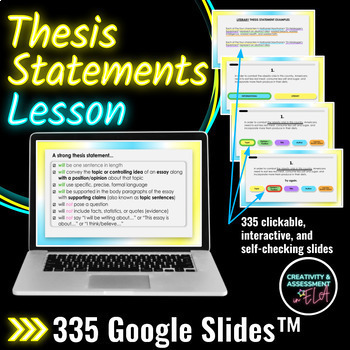
Thesis Statements Mini Lesson Interactive Game Activity with Google Slides
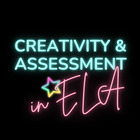
- Google Slides™
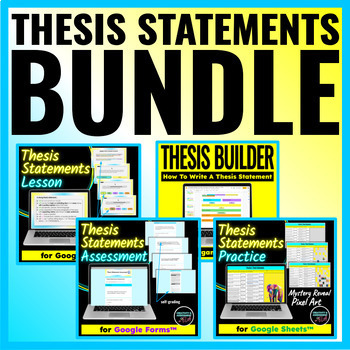
Thesis Statements BUNDLE | Digital Lesson Game , Practice, & Formative Assessment

Thesis Statement Scoot Game /Task Cards

Yes/No Thesis Game
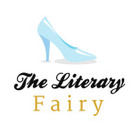
Thesis Throwdown Class Game : Middle & High School Thesis Writing Practice

- Google Drive™ folder
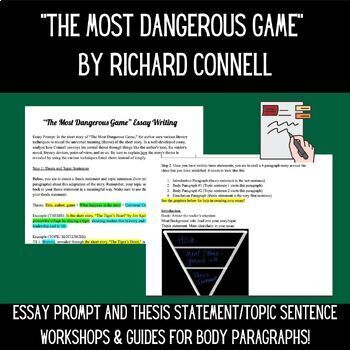
"The Most Dangerous Game " Essay Prompt, Thesis and Topic Sentences + More!

- Google Docs™
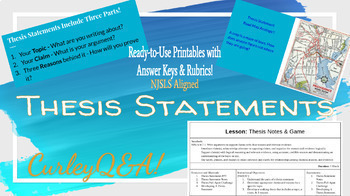
Thesis Statements - Thesis Game Challenge & Step By Step Writing

Thesis Statements Jeopardy Game

Writing an Effective Thesis Statement: Slide Presentation and Blooket Game Link

- Internet Activities
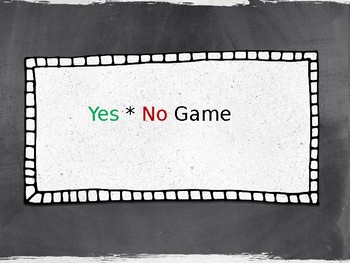
"I Dissent" board game FRQ thesis practice

- Word Document File
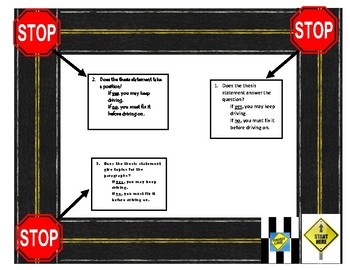
Thesis Game

Game Winning Thesis Statements!

Music Theory BOOM Cards BUNDLE - Music Games for Google Classroom™ and more!

Thesis Statement Practice Task Cards

Fun Essay Hooks Writing Game and Practice Activity for Middle School ELA


How to Write a Thesis Statement Mini Lesson and Activities

Thesis Statement Digital Escape Room Argumentative Writing Digital Resources

- Google Apps™
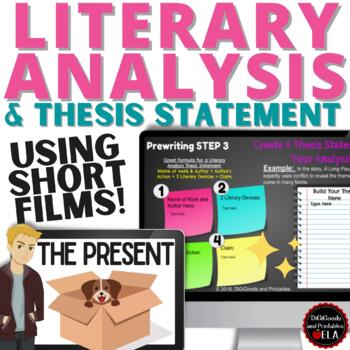
Literary Analysis Essay Writing and Thesis Statement With Short Film Activities

CSI: Protestant Reformation Activity - Fake News Game - Printable & Digital
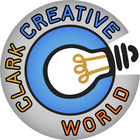
Escape Room Break Out Box Game , Parts of an Essay (Mini)

“The Most Dangerous Game ” Character Analysis Unit -Digital for Distance Learning
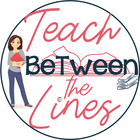
Literary Terms Review Game or Task Cards - 100 Questions

Argumentative Essay Writing - Rubric - Graphic Organizer - Violent Video Games

- Easel Assessment
- We're hiring
- Help & FAQ
- Privacy policy
- Student privacy
- Terms of service
- Tell us what you think
Amazon Prime’s free games for June revealed
Rachael Davies has spent six years reporting on tech and entertainment, writing for publications like the Evening Standard, Huffington Post, Dazed, and more. From niche…
Owen Good is a 15-year veteran of video games writing, also covering pop culture and entertainment subjects for the likes of Kotaku and Polygon. He…

Amazon Prime members can claim and play seven games for free next month, according to a newly-published schedule.
Members of Amazon Prime get free games to play each month , with new ones coming a each week begins. The same will happen in June, with seven games on the way in the coming weeks. Next month, titles range from some Star Wars classics to funky cowboy-based adventures.
One of the first games to become available on June 8 is Star Wars Battlefront II Classic, taking us back to 2005 when the popular sequel title first came out – which is better than the glitch-fueled reboot of late. Battlefront II follows Clone Troopers from different factions fighting in various locations around the galaxy far, far away locales. The game introduced new elements to the franchise, including missions based on Episode III: Revenge of the Sith, as well as enhanced gameplay like space combat and the ability to play as Jedi characters or other heroes.
For something a little less mainstream, Weird West offers a fantasy-RPG where cowboys take on dangerous supernatural beasts. Meanwhile Genesis Noir follows “No Man” as he’s caught in a love triangle with cosmic beings and gods.
Other games coming later in the month include Everdream Valley, a farming adventure game; MythForce, which offers roguelike action in a 1980s cartoon setting; Projection: First Light, a puzzle-focused game set in a shadow world, and the action-packed Blast Brigade vs. the Evil Legion of Dr. Cread – which is exactly what it sounds like.
Amazon Prime free games for June release schedule
Here’s a breakdown of when each game will become available to Amazon Prime members. You’ll be able to access them instantly from within your account, so long as you’re subscribed to Amazon Prime.
- Star Wars Battlefront II Classic
- Weird West Definitive Edition
- Genesis Noir
- Everdream Valley
- Blast Brigade vs. the Evil Legion of Dr. Cread
- Projection: First Light
Featured image: Pandemic Studios via IGDB
About ReadWrite’s Editorial Process
The ReadWrite Editorial policy involves closely monitoring the tech industry for major developments, new product launches, AI breakthroughs, video game releases and other newsworthy events. Editors assign relevant stories to staff writers or freelance contributors with expertise in each particular topic area. Before publication, articles go through a rigorous round of editing for accuracy, clarity, and to ensure adherence to ReadWrite's style guidelines.

Rachael Davies Tech Journalist
Rachael Davies has spent six years reporting on tech and entertainment, writing for publications like the Evening Standard, Huffington Post, Dazed, and more. From niche topics like the latest gaming mods to consumer-faced guides on the latest tech, she puts her MA in Convergent Journalism to work, following avenues guided by a variety of interests. As well as writing, she also has experience in editing as the UK Editor of The Mary Sue , as well as speaking on the important of SEO in journalism at the Student Press Association National Conference. You can find her full portfolio over on…
Related News
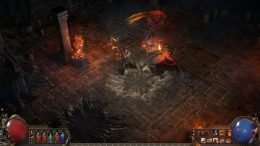
Path of Exile 2 coming to consoles by the end of the year

PlayStation State of Play, May 2024: Everything announced
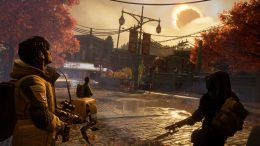
Xbox Game Pass exclusive Redfall gets one last patch on its way out the door

Mistral AI introduces its first LLM for coding, fluent in 80 programming languages
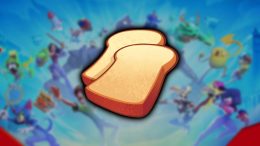
What does Toast do in MultiVersus?
Most popular tech stories.
- EA revealed how much Apex Legends has made and…it’s a lot
- Best Online Casinos Australia for Real Money in 2024
- Beautiful flying adventure Kid Pilot set to hit Steam VR later this month
- Dogecoin Maxi DonAlt Posts $1 Price Prediction – Risk On For Meme Coins?
- ChatGPT-5: release date, price, and what we know so far
Latest News
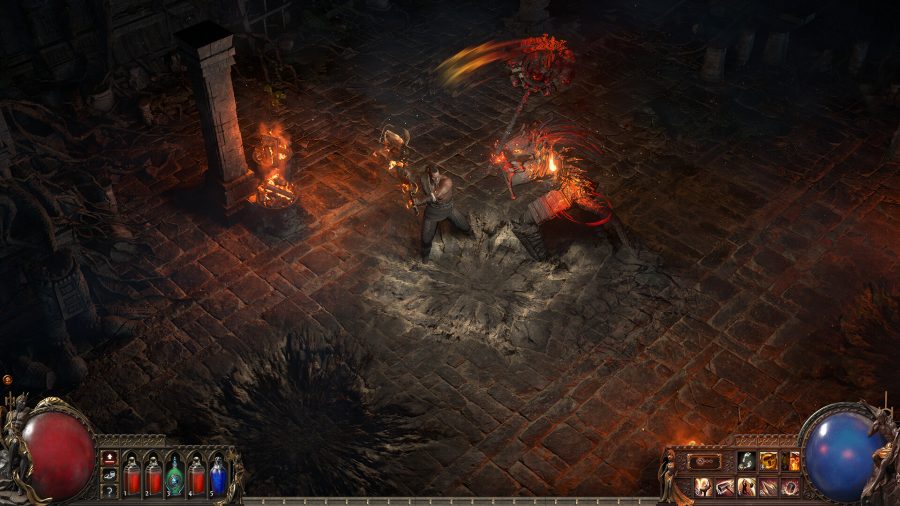
New Zealand’s Grinding Gear Games has announced its plans to bring its popular action RPG Path of Exile 2 to Xbox and PlayStation by the end of this year and...

XRP Price Prediction As Ripple Lawsuit With SEC Has This New Update

Up or Down For Bitcoin Next? Bonk Sees Fresh Interest; Rebel Satoshi Arcade Becomes New Meme Favorite

Ethereum Mass Institutional Adoption An Enormous Tailwind For Kai Cat Coin

Popular Topics

Get the biggest tech headlines of the day delivered to your inbox
By signing up, you agree to our Terms and Privacy Policy. Unsubscribe anytime.
Explore the latest in tech with our Tech News. We cut through the noise for concise, relevant updates, keeping you informed about the rapidly evolving tech landscape with curated content that separates signal from noise.
Explore tech impact in In-Depth Stories. Narrative data journalism offers comprehensive analyses, revealing stories behind data. Understand industry trends for a deeper perspective on tech's intricate relationships with society.
Empower decisions with Expert Reviews, merging industry expertise and insightful analysis. Delve into tech intricacies, get the best deals, and stay ahead with our trustworthy guide to navigating the ever-changing tech market.
Engineering cells to broadcast their behavior can help scientists study their inner workings
Assistant Professor of Biochemistry, University of Wisconsin-Madison
Disclosure statement
Scott Coyle receives funding from the National Institute of Health, the National Science Foundation, and The David and Lucile Packard Foundation
University of Wisconsin–Madison provides funding as a member of The Conversation US.
View all partners
Waves are ubiquitous in nature and technology . Whether it’s the rise and fall of ocean tides or the swinging of a clock’s pendulum, the predictable rhythms of waves create a signal that is easy to track and distinguish from other types of signals.
Electronic devices use radio waves to send and receive data, like your laptop and Wi-Fi router or cellphone and cell tower. Similarly, scientists can use a different type of wave to transmit a different type of data: signals from the invisible processes and dynamics underlying how cells make decisions.
I am a synthetic biologist , and my research group developed a technology that sends a wave of engineered proteins traveling through a human cell to provide a window into the hidden activities that power cells when they’re healthy and harm cells when they go haywire.
Waves are a powerful engineering tool
The oscillating behavior of waves is one reason they’re powerful patterns in engineering.
For example, controlled and predictable changes to wave oscillations can be used to encode data, such as voice or video information. In the case of radio, each station is assigned a unique electromagnetic wave that oscillates at its own frequency. These are the numbers you see on the radio dial.
Scientists can extend this strategy to living cells. My team used waves of proteins to turn a cell into a microscopic radio station, broadcasting data about its activity in real time to study its behavior.
Turning cells into radio stations
Studying the inside of cells requires a kind of wave that can specifically connect to and interact with the machinery and components of a cell.
While electronic devices are built from wires and transistors, cells are built from and controlled by a diverse collection of chemical building blocks called proteins . Proteins perform an array of functions within the cell, from extracting energy from sugar to deciding whether the cell should grow.
Protein waves are generally rare in nature, but some bacteria naturally generate waves of two proteins called MinD and MinE – typically referred to together as MinDE – to help them divide. My team discovered that putting MinDE into human cells causes the proteins to reorganize themselves into a stunning array of waves and patterns .
On their own, MinDE protein waves do not interact with other proteins in human cells. However, we found that MinDE could be readily engineered to react to the activity of specific human proteins responsible for making decisions about whether to grow, send signals to neighboring cells, move around and divide.
The protein dynamics driving these cellular functions are typically difficult to detect and study in living cells because the activity of proteins is generally invisible to even high-power microscopes. The disruption of these protein patterns is at the core of many cancers and developmental disorders.
We engineered connections between MinDE protein waves and the activity of proteins responsible for key cellular processes. Now, the activity of these proteins trigger changes in the frequency or amplitude of the protein wave, just like an AM/FM radio. Using microscopes, we can detect and record the unique signals individual cells are broadcasting and then decode them to recover the dynamics of these cellular processes.
We have only begun to scratch the surface of how scientists can use protein waves to study cells. If the history of waves in technology is any indicator, their potential is vast.
- Engineering
- Cell biology
- Electromagnetic waves
- Quick reads
- Picture in 500 words

Data Manager

Research Support Officer

Director, Social Policy

Head, School of Psychology

Senior Research Fellow - Women's Health Services
Recap: JR Radcliffe hosted live chat on the Brewers and Thursday's game against Craig Counsell's Cubs

The Milwaukee Brewers' 6-4 victory over the Chicago Cubs on Thursday afternoon was the finale of the Brewers' four-game series with their rivals. Milwaukee won three of the four games in the series, ex-Brewers manager Craig Counsell's first back in Milwaukee since he became the Cubs manager.
Before and during the game, Journal Sentinel reporter JR Radcliffe fielded your questions and comments about the Brewers, in general, and the game, in particular.
Here's a recap of the live chat:
That's all for the Q&A today; thanks for writing!
Hope you enjoyed the Q&A during today's Brewers-Cubs game and had a good time watching the series. I still expect these will be the two teams duking it out for the Central this season.
A Brewers-Mets trade perhaps?
VERNON: With the Mets seemingly on a downswing, could we have a Stearns to Arnold (aka Mets to Brewers pipeline) at trade deadline? Marlins, White Sox, who else seem to be "locks" to sell at this early stage ?
JR: I wouldn't rule it out; the teams already made a big move in the offseason when Adrian Houser and Tyrone Taylor went to the Mets. I was eager to see if New York would move Pete Alonso last year, since I thought the Brewers might be a contender for the first baseman's services, but the deal didn't even really make sense then and makes less sense now. But a pitcher, perhaps?
The Athletics will probably sell (again), along with the Rockies, Angels and the teams you mentioned. It goes without saying that a broader playoff field diminishes the number of teams truly "out of it" by the deadline, though. It's not the treasure trove it used to be. I wouldn't even say with certainty that the Mets will be out of it.
Is Craig Counsell managing the Cubs differently than the Brewers?
GIUSEPPE: Is Counsell managing the Cubs any differently than he did the Brewers, as much as you can glean from afar?
JR: I'd say not really thus far; in fact, the teams are pretty similar. Last year's Brewers had a collection of aces and so-so offense. Counsell also uses his bullpen similarly, keeping guys fresh by not committing to the "A" bullpen even during close deficits. In fact, that style caught the ire of some Cubs fans already this year and became a topic on talk radio. Obviously, it's early. Counsell was a manager who achieved long-term results in Milwaukee, and two months is barely enough data to glean in terms of managerial tendencies. Although don't tell a Chicago fan that!
Did a local Brewers writer just jinx Bryan Hudson?
CONNIE ARNDT: Tyler K can take that blame or the 2 run homer Hudson just gave up. He just wrote a story championing Hudson as rookie reliever of the year. Hope it is just a case of the man would not be perfect all year long, just like the Cubs' ace last night.
Connie is talking about Tyler Koerth, who wrote for Reviewing the Brew, asking if Hudson could be a sneaky NL Rookie of the Year candidate. Hudson has an uphill battle competing with Shota Imanaga of the Cubs and Yoshinobu Yamamoto of the Dodgers, but I suppose anything is possible.
Like Connie said, Hudson was bound to give up runs sooner or later. He still has a pretty slick 0.87 ERA this year even after the home run.
What has Bob Uecker's schedule been this season?
MIA PROSSER : Is Bob Uecker still doing every home game and no road games, or has he decided to take it easy and do less? Cannot blame him and love how flexible the Brewers are with him.
JR: Bob's been here for a lot of home games this year but not all; he was here on Monday but I don't believe he's been here the rest of the series. The team said before the year he would take it "one day at a time" with home games, and that's what we've seen. You're correct that he does not do road games and hasn't for a few years.
Should the Brewers send Jake Bauers to the minors?
SPARKY HAMPSHIRE: Is playing every day hurting Bauer's offensive performance? While I like the occasional power and great defense, save for last night, would minors help him, or is he out of options?
JR: Yes, Bauers is out of options, but I wouldn't say he's the type of player who needs the minors; his numbers with Milwaukee are right in line with everything he's done in his big league career. He's 28, so it's not like we have to think of him as a fully finished product but ... he kind of is what he is, a backup first baseman who's perfect for a team that has a healthy Rhys Hoskins.
When is the Major League Baseball draft?
JIAMING: When is the draft? Eager to see who we pick with the Corbin Burnes draft pick .
JR: The draft runs July 14-16 (during all-star weekend). The Brewers have the No. 34 pick in the draft as part of the Corbin Burnes exchange with Baltimore, in addition to already having the No. 17 pick.
One thing I'd point out is that the Brewers stood to get a pick anyway even if Burnes had signed as a free agent somewhere else; it just wouldn't have been for this draft (because Burnes would have theoretically signed after the 2023 season, but the pick probably would have been around the same part of the draft). This part of the arrangement insured the Brewers could have their cake (get players) and eat it too (still get a pick).
UPDATE FROM JIAMING: Your "have cake and eat it too" has me searching my cupboards for a snack, lol. Do Brewers continue to seek college hitters in the draft, or will this be the year of the pitcher?
JR: I feel like last year was the year of the pitcher. Sixteen of their 21 signings were pitchers, and some have some significant upside, although the highest profile guys (Wilken, Pratt, Bitonti, Boeve) happen to be some of the hitters. The slot system of the draft makes the draft so hard to project in terms of strategy by position; the strategy is to bank as much money as you can in the first 10 rounds from your signing pool and use it to bring in one or two bonus babies. Those guys have been pitchers (Misiorowski) and position players (Bitonti, Pratt) alike.
Four left-handers on one Brewers staff?
ZHOU GIRARD: If DL Hall comes back to serve as a reliever, do you ever recall 4 LH relievers on a Brewer staff, or any team for that matter?
JR: It's unusual but not unheard of, I'd surmise. In the era where you have to face a minimum of three batters, I don't know if left-handedness is treated as much as a novelty as before, but that doesn't necessarily equate to four lefties on a staff. The 2022 team had Milner, Suter, Hader and Aaron Ashby in kind of a hybrid role, but I don't know offhand if they were all there at the same time.
What comes next for Willy Adames?
WILL VENSKI: What are the Brewers going to do about Adames? The team is highly likely to be in contention at the trade deadline, so trading him seems not only remote but ill advised. Allowing him to walk away with only a supplemental draft pick in return doesn’t make much sense. Yet there is absolutely no mention, even speculation, about re-signing him. Is there even a possibility that they can afford him?
JR: We kicked off the chat with some Adames stuff, but it's buried at the bottom, so I'll re-post what I wrote here.
It feels like that opportunity has passed. Adames is at the very front of a brutally weak shortstop free-agent class this offseason, and it probably makes the most sense for him to test the market. Somebody is going to pay him a lot of cash. Meanwhile, the Brewers have equipped themselves with future options, with both Joey Ortiz and Brice Turang looking like capable replacements, especially Ortiz.
Which Brewers pitchers can actually hit if they had to?
VERNON APPLE: Which of our pitchers can actually hit, now that Woody is out for the year? We came close to needing a pitcher to hit recently.
JR: Great question! After some informal speculation up in the press box, we're going to guess Colin Rea, but the numbers he does have in the Majors and minors at the plate are not great. We might turn this into some sort of investigation later.
Curt Hogg, a basketball or baseball talent?
THERESA DODGE: Was Curt Hogg a better basketball or baseball player in his youth?
JR: My sources tell me that despite Curt being tall (6-5), he was a better baseball player in high school (though possibly not particularly good at either sport). He said he's much better at basketball today, for what it's worth.
UPDATE FROM THERESA: I have a good hunch on the source for the talent evaluation for a certain 6'5" human. ha ha. And speaking of pitchers who can hit, is Greinke still out there? Would he be a good reliever at this stage
JR: Yes, Curt is sitting right next to me. As for Greinke, he IS still out there. I don't know if he has anything left, but I would selfishly love to see him back in baseball, and Milwaukee is just as good a place as any. And yes, the dude can hit.
The Freddy Peralta conundrum
NATHAN: On a personal level, I love Freddy Peralta. Seems like a great teammate and competitive gamer. While possessing raw talent, there are some things that drive me crazy about him: propensity to surrender the long ball, high pitch counts early in the game, and not necessarily pitching the best in the biggest games. His last start seems like a microcosm of him overall: strikes out 11, but gives up a homer and goes 5 2/3 with 111 pitch count. Before his last start, his WAR was 0.9, so it seems like I'm not being overly harsh. what are your thoughts in Freddy? Is there something between the ears that still needs to come together?
JR: We've seen enough of Freddy now to safely assess that this is who he is as a pitcher. Electric stuff but a propensity to get unpredictable, leading to walks and struggles later in the games. The biggest problem is that it seems to put a ceiling on how deep he can go into games; at this point, I think it's satisfying if he makes it through six and an outright surprise if he goes deeper. I don't think you're being harsh. I just think that's who he is and how his stuff plays. His last two starts have been really, really strong.
Does this Brewers season count as a surprise?
FROM SD: You are a great Brewers source. Are you surprised by the Brewers this year? And do you think it can be maintained for the remaining 100+ games ?
JR: I've gone on record as saying I believed this was a .500 team, and even after a strong April, I thought this team could still easily end up at or below .500. It's getting harder to justify that belief between the way the team has shown it can win games and the wins it's already banked. I do sometimes think about the 2014 team that seemed to be playing way over its head halfway through the year and crashed back to earth.
But now, I think it'd be pretty pessimistic to believe this is a .500 or below team. They haven't even had a fully healthy complement of offensive players (Yelich, Hoskins, Mitchell) or their closer (Devin Williams) all season, and they haven't yet played some of the really bad teams in the league (White Sox, Rockies, Angels, Athletics). I still don't think this team has the firepower (yet) to run away with the Central, though. It should be a dogfight through the summer.
When will Garrett Mitchell and Devin Williams return?
BEVERLY: When will Devin Williams and Garrett Mitchell be back in the lineup?
LIAM LUCAS: Is the Frelick 3rd base thing just on hold due to outfielder injuries? When is Mitchell due back?
JR: Williams is hoping to get back by the end of July, and Mitchell could be back as soon as mid-June, but he'll have to make a trip to the Arizona complex first. And yeah, until he gets back, I don't imagine Frelick getting reps at third base on a consistent basis. Ortiz has really established himself there, and the club really likes Oliver Dunn. Since Frelick hasn't torn the cover off the ball, I'm not sure it makes a ton of sense to force Frelick into the lineup as a third baseman against a right-handed pitcher, when you can just use Dunn.
Bryan Hudson, closer?
NADIA FAITH: Will Hudson get some save opp's, or will Murphy stick with him in fireman plus piggyback role when starters only go 4/5 innings ?
JR : I definitely think he'll get some saves out of the current setup, especially with Trevor Megill briefly sidelined. Heck, today might be the day for it, given how much the rest of the bullpen worked the last two days. But there's so much value in that multi-inning role; think Josh Hader in 2019. Murphy hasn't been strictly committed to a closer without Devin Williams, even though Megill has kind of taken some of those opportunities lately.
Brewers baserunning shows itself off in three-run second
S_MCANDERSON: Sal cutting the bases like Christian Yelich! Did you know the Brewers are lapping the league in BsR on FanGraphs?
JR: The Brewers are indeed well ahead of the pack in Fangraphs' measure of baserunning with 8.4 runs above average. Washington is next at 5.0. We just saw two great decisions in a three-run second inning, where both Joey Ortiz and Sal Frelick slid ahead of a great throw by left-fielder Ian Happ.
Can the Brewers upgrade their bench at the deadline?
OWEN DAVIS: When trade deadlines approaches, obviously starters/relievers are targets. Right now our bench bats need upgrades IMO.
JR: Great bench bats: A nice luxury to have, and one that I think can happen simply by adding Tyler Black from within. I think your first instinct is right, though. The trade deadline is almost always about relief pitching and, if the Brewers can somehow meet the price, a starting pitcher would be huge.
Did Craig Counsell meet with former players?
JOE: Did Counsell and former Brewer players chat in the pre games? If so, openly or was it behind the scenes?
JR: We saw Craig Counsell chatting with William Contreras on the field, and I'm sure he caught up with a few guys — probably even more behind the scenes. Like you can tell from Curt Hogg's story earlier this month before the series in Chicago , there aren't really any hard feelings among the players, and baseball doesn't really lend itself to that sort of thinking. I'm sure everyone is still on great terms.
Jeferson Quero's injury
JOE AKA GIUSEPPE: Do you think the Brewers will advise Jefferson Quero to stop trying to steal and to only slide feet first? Seems both injuries happened sliding.
JR: Quero's season-ending shoulder injury came on a pickoff play, so he's not diving feet-first on that particular play. It's a terrible break, and the Brewers obviously have some history with this level of misfortune (see Nelson, Jimmy), but I don't think that one could have been prevented with different technique.
UPDATE FROM JOE: thanks on Quero, not suggesting he go feet first on a pickoff, I am suggesting he not even tempt fate with long leadoff's. Two shoulder injuries already seems a trend to me. His throwing arm is his ticket to big leagues, not stealing bases.
JR: A good point; He's not a speedy runner, so I hear what you're saying about just taking it easy on the basepaths. I don't know if I could see the team asking him to restrict his activity on the bases, especially when they do still value him as an offensive player. But obviously it makes some sense, especially when he first returns, to avoid getting too aggressive.
Did Craig Counsell make a mistake holding Shota Imanaga back?
MAX: To quote Crash Davis, “Never f#<* with a winning streak.” Do you think CC erred by bumping Imanaga back? Totally understand the reasoning but I gotta agree with Crash on this one.
JR: Max is referring to the Cubs decision to push Shota Imanaga's start back from the previous series against St. Louis after a rain delay into the Brewers series, where Milwaukee tagged him for seven runs. I don't subscribe to the Crash Davis philosophy, personally. All pitchers could use extra rest here and there, and as great as Imanaga has been, I think he was due for at least a little bit of regression, and the Brewers had the honor of delivering it all at once. Milwaukee will take it, but I have this sneaky suspicion that Shota will have success against the Brewers next time out.
Whither Joey Wiemer?
TOM S: Will Joey Wiemer make it back up this year without an OF injury?
JR: I think so? But he's struggling in limited work at Triple-A and he's got to keep getting work in at the lower levels to figure out his swing. I think there's a mountain of talent still in that bat, and we know he can play the outfield. But I'm not sure I'd even feel comfortable guessing at a timeline for his return to the big leagues.
Bigger surprise: Brice Turang or Joey Ortiz?
S_MCANDERSON: Two of the biggest surprises on the offense have been Brice Turang and Joey Ortiz. Who has surprised you more? Do you think either/neither/both will sustain their current level of production?
JR: I am shocked by Brice Turang, honestly. Leaning all the way into the hit tool has paid off handsomely for him and accentuates the things he's good at. Last year by season's end, I wasn't sure his offensive production could justify the lineup spot, even with the glove being good. Now, he's one of the most valuable players on the team. I'm not sure if I've quite bought into the idea that he can sustain this level of success all year, though.
Ortiz, meanwhile, seems like he has greater potential to get even better, although this level of offense has also been a welcome surprise. I feel stronger about his chances of sustaining this all year long, but I suspect he'll have some rookie slumps, as well.
Is Brewer Hicklen an option for the Brewers?
S_MCANDERSON: Will Brewer Hicklen ever be a Brewer?
JR: He has 11 homers and a .983 OPS at Triple-A Nashville. He is absolutely on my list of players that I expect to play for the Brewers at some point this year, though right now he's not on the 40-man roster, so that makes it a little more difficult. If the team were to send Chourio down or run into another outfield injury (unless Joey Wiemer starts to show major signs of improvement), I really believe Hicklen is an option. He might need to get a little more seasoned on defense, too.
Are the Cardinals the team to beat in the Central again?
S_MCANDERSON: Cardinals are now back in 2nd. Who do you think will end there (presuming, of course, the Brewers are in first)
JR: Cardinals are on a hot streak right now, but I'm not buying it yet. I'll always live in a headspace of "you can never, ever count out the Cardinals," but I still believe this will be a division race between the Cubs and the Brewers.
Will Jackson Chourio remain in the big leagues all year?
DOUG: Do you think they will send Jackson Chourio down to minors at some point?
JR: I don't think they will, personally, but it's obviously not something that's completely off the table. The talent has shown itself in flashes, and his previously showcased ability to adjust tells me one thing: He needs to get reps at the big-league level. This is the best place for him to keep getting better, and I'd wager he'll get better quickly. I think Brewers fans would be right to feel uneasy about his play in the outfield and could argue that's a craft better honed in the minors, but I don't see it as a big enough issue yet.
Pat Murphy has made this a seamless transition
SUPER G: Murphy appears the perfect successor to Counsell, who established himself as the best skipper in the game while with the Crew. Murph brings a harder edge but the transition could not have been more seamless.
JR: This is notably the time of year when we can start saying "results are results." Although that axiom isn't always true, the Brewers appear to be a winning ballclub contending for a divisional title in a year where they lost their two best pitchers (like, maybe the two best in franchise history ) and have had to piece a rotation together. What's not to like? Murphy has to be on the short list of Manager of the Year candidates thus far.
Keep in mind, too, it's not just Murphy who's helped make this so seamless; the Brewers brought back a massive chunk of last year's coaching staff. It's the same hitting coaches, same pitching coaches, same base coaches. Many of the things they implemented have stayed put.
Better production at first base?
PB: 1/3 of the way through the year and we are getting little production at first base. Any options out there?
JR : I'd push back a little there; Rhys Hoskins is still tied for the team lead with nine homers and has a nice .813 OPS. He's obviously hurt right now but is close to returning. And Jake Bauers hasn't been a world-beater but he wasn't expected to be. He's still played his role, I'd argue, especially defensively.
If Hoskins is slow to return and the team feels it simply has to upgrade there, the first move is to bring Tyler Black back from AAA.
What's the status of a William Contreras extension?
SCOTT: Speaking of extensions — it doesn't sound like William Contreras is interested in exploring an extension that buys out some years of free agency, but might the Brewers, with what appears to be a generational talent at backstop, be able to entice him? Would Attanasio open the coffers?
JR: It's absolutely something they have to be exploring, even though he doesn't become a free agent until 2028. Last year, Contreras told my colleague, Curt Hogg, that he was open to an extension, but the messaging has maybe cooled a little bit this year, which makes sense given that he's having an MVP-caliber season and should have a much higher price tag this time around.
The question the Brewers are presumably investigating: Can a long-term extension with a catcher work out? Players at the position famously don't age gracefully, though there's a long history of converting catchers to first basemen to prolong their careers.
The Brewers have shown they are willing to dole out extensions selectively; that is, to MVP caliber players like Christian Yelich, who signed his extension with two seasons remaining on his previous deal. The Brewers have a little more time here, but it's not getting cheaper as time passes.
Willy Adames long-term contract?
Let's get this thing started on a beautiful Thursday in Milwaukee. I'm perched in the American Family Field press box alongside my colleague, Curt Hogg, to take in the Brewers and the Cubs.
TONY: Is there any chance of the Brewers signing Willy Adames to a contract?
JR: It feels like that opportunity has passed. Adames is at the very front of a brutally weak shortstop free-agent class this offseason, and it probably makes the most sense for Adames to test the market. Somebody is going to pay him a lot of cash. Meanwhile, the Brewers have equipped themselves with future options, with both Joey Ortiz and Brice Turang looking like capable replacements, especially Ortiz.

IMAGES
VIDEO
COMMENTS
Here's how it works: Step 1: Write an essay prompt on the board. I vary my questions between informative and argumentative topics. KQED's Do Now series is an excellent place to grab writing prompts! Step 2: Put students into small groups and give them 5 minutes to construct a solid thesis statement in response to the essay question.
4. Daily Practice Activities to Teach How to Write a Thesis Statement. One of the most effective ways to teach how to write a thesis statement is through repeated practice. You can do this by incorporating daily bell ringers into your persuasive writing unit. To assign this activity, I provide students with three topics to choose from.
Thesis Activity. One way to think about a thesis statement is: An effective thesis is one that is not obvious; rather it is one that is discussible, arguable, and interesting. Avoid self-evident statements. In the US, movie stars are greatly admired. A strong thesis will give readers an idea of the general direction of your paper and the ...
Thesis statements are statements that are arguable and that state a writer's stance on a subject. Typically, a good thesis statement serves as a blueprint of an essay or paper that readers can use to follow along. Thesis statements give focus and organization to your writing, but sometimes they can be ...
In the lower right corner of the activity, click the printer icon. (NOTE: This is not the Print button at the bottom of the page.) Select either Print all slides or Print current slide.On the Print popup, under Destination, click the Change… button. Select Save as PDF.In the Print popup, click the Save button In the Save As popup window, give the file a name.
The following activities will help reinforce the concept. Have students create thesis statements on a slice of paper. Collect the paper and read them to the class. Have the class vote on them. Do the same activity, but use individualized white boards to record judgments. Read the thesis statements anonymously.
Step 1: Start with a question. You should come up with an initial thesis, sometimes called a working thesis, early in the writing process. As soon as you've decided on your essay topic, you need to work out what you want to say about it—a clear thesis will give your essay direction and structure.
Thesis Writing Activities: LEGOs, Graphic Organizers, and Superman. A few years ago, we were discussing how our own young children were already practicing scientific thinking. As early as kindergarten, some students could clearly define and develop hypotheses. As mothers of elementary-aged students, and as educators at the middle school level ...
Part I: Possible Example Thesis Statements. Choose the best revision for each thesis statement. 1) "The Raven" is a dark and morose poem that leaves the audience feeling depressed by the last stanza. Poe succeeds in creating that effect in "The Raven" through use of repetition and adds to it through contrast of religious Christian and ...
A thesis statement: tells the reader how you will interpret the significance of the subject matter under discussion. is a road map for the paper; in other words, it tells the reader what to expect from the rest of the paper. directly answers the question asked of you. A thesis is an interpretation of a question or subject, not the subject itself.
About this Worksheet: Practice developing thesis statements with this writing introduction worksheet! Students will learn how to improve their writing with a strong, attention grabbing thesis statement. This activity helps build writing skills by asking students to create a statement for the topics provided, such as: "What was the greatest ...
A good thesis has two parts. It should tell what you plan to argue, and it should "telegraph" how you plan to argue—that is, what particular support for your claim is going where in your essay. Steps in Constructing a Thesis. First, analyze your primary sources. Look for tension, interest, ambiguity, controversy, and/or complication.
The Argument Games bundle will provide you with five collaborative, active games that will have students creating arguments, counter-arguments, evaluating perspectives and sufficiency of evidence! A list of interesting and unique arguable topics can be found within this unit, as well as classroom signs for the games!
Writing a Thesis Statement Free Lesson Plan. Here is a guided writing workshop to teach students how to brainstorm and draft a thesis statement. This activity provides students an opportunity to consider their prompt and develop a claim that is effective and arguable. Three handouts are included in each download, with the teacher version also ...
At the Writing Center, we work one-on-one with thousands of student writers and find that giving them targeted writing tasks or exercises encourages them to problem-solve, generate, and communicate more fully on the page. You'll find targeted exercises here and ways to adapt them for use in your course or with particular students.
Thesis Statement Writing Workshop. If you are thinking about trying to get your students thinking and writing critically this is a great place to start. This 50 minute workshop gets kids thinking, creating and collaborating. Kids travel from station to station to learn about thesis statements and they have fun while they're at it.
A thesis is an in-depth research study that identifies a particular topic of inquiry and presents a clear argument or perspective about that topic using evidence and logic. Writing a thesis showcases your ability of critical thinking, gathering evidence, and making a compelling argument. Integral to these competencies is thorough research ...
A thesis statement is a sentence in a paper or essay (in the opening paragraph) that introduces the main topic to the reader. As one of the first things your reader sees, your thesis statement is one of the most important sentences in your entire paper—but also one of the hardest to write! In this article, we explain how to write a thesis ...
Revised on April 16, 2024. A thesis is a type of research paper based on your original research. It is usually submitted as the final step of a master's program or a capstone to a bachelor's degree. Writing a thesis can be a daunting experience. Other than a dissertation, it is one of the longest pieces of writing students typically complete.
1. 📑 Word Processors and Note-Taking Apps. This should be a no-brainer, but writing is one of the essential parts of creating a thesis. So it's evident that you need to have the best thesis apps to deal with this task effectively. Here are some apps that you might want to check out. Google docs.
Thesis. Your thesis is the central claim in your essay—your main insight or idea about your source or topic. Your thesis should appear early in an academic essay, followed by a logically constructed argument that supports this central claim. A strong thesis is arguable, which means a thoughtful reader could disagree with it and therefore ...
Browse thesis games resources on Teachers Pay Teachers, a marketplace trusted by millions of teachers for original educational resources.
Microsoft Word - Document1. Directions: Carefully read the writing prompt and the Bad Thesis Statement. Then, rewrite a Good Thesis Statement. State the subject and tell the author's purpose for writing or the point to be proved. A good thesis statement will directly respond to each part of the writing prompt.
Amazon Prime members can play, download and keep seven games for free next month, including Star Wars Battlefront II and MythForce. ... Owen Good is a 15-year veteran of video games writing, also ...
The New York Times just added the Wordle Archive, which gives players the ability to go back and play every single previous Wordle that's ever been released, all the way back to June 19th, 2021 ...
dietyfyindia on May 30, 2024: "Thesis complete! After countless hours of research, writing, and revisions, I'm thrilled to share that my postgraduate journey ha ...
Researchers can create 'single-cell radios' using bacterial proteins to transmit the invisible activities within cells. ... Write an article and join a growing community of more than 184,500 ...
What Are Today's Quordle Hints? Word 1 (top left) hint — muscular strength. Word 2 (top right) hint — thing done with ease. Word 3 (bottom left) hint — that which belongs to whom. Word 4 ...
Scroll slowly! Just after the hints for each of today's Connections groups, I'll reveal what the groups are without immediately telling you which words go into them. Today's 16 words are ...
Recap: JR Radcliffe hosted live chat on the Brewers and Thursday's game against Craig Counsell's Cubs. The Milwaukee Brewers' 6-4 victory over the Chicago Cubs on Thursday afternoon was the finale ...